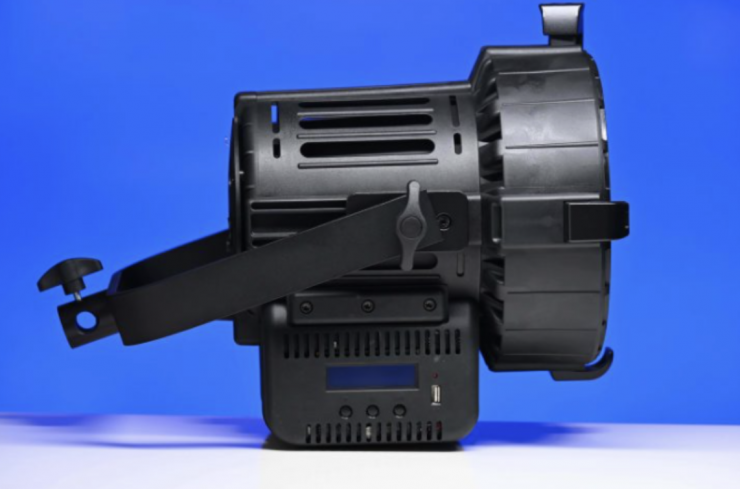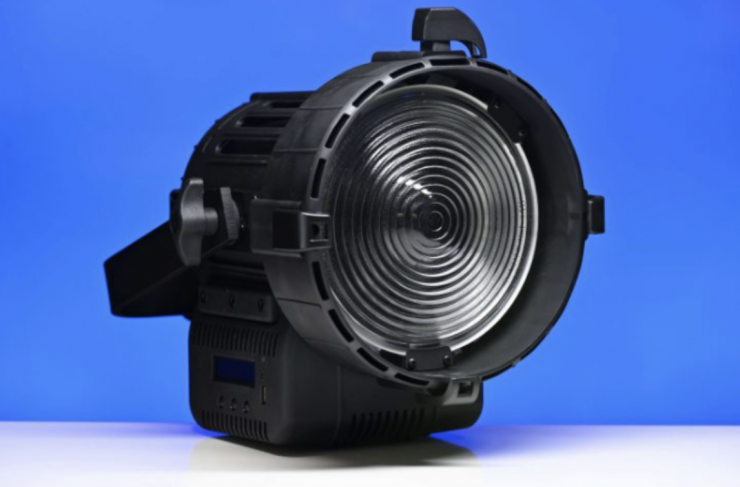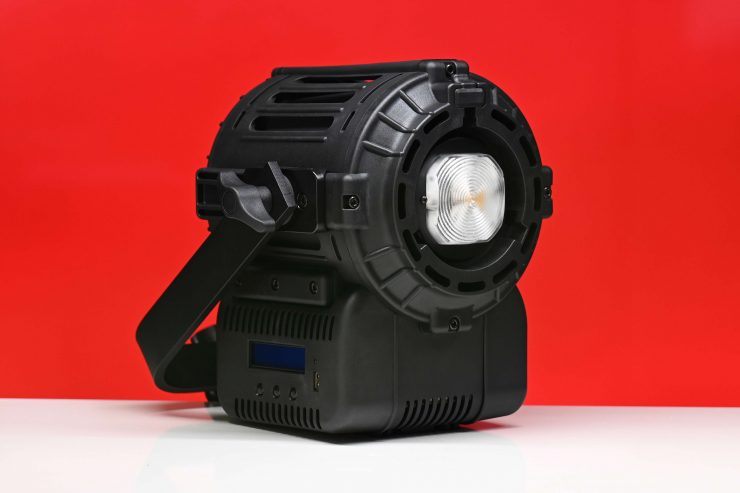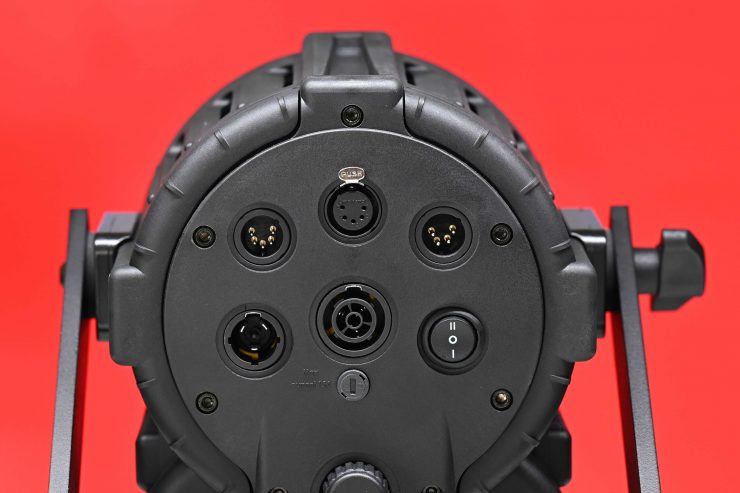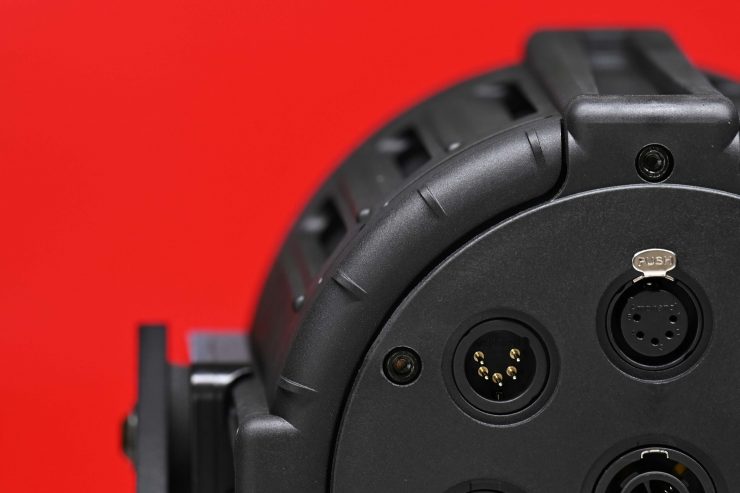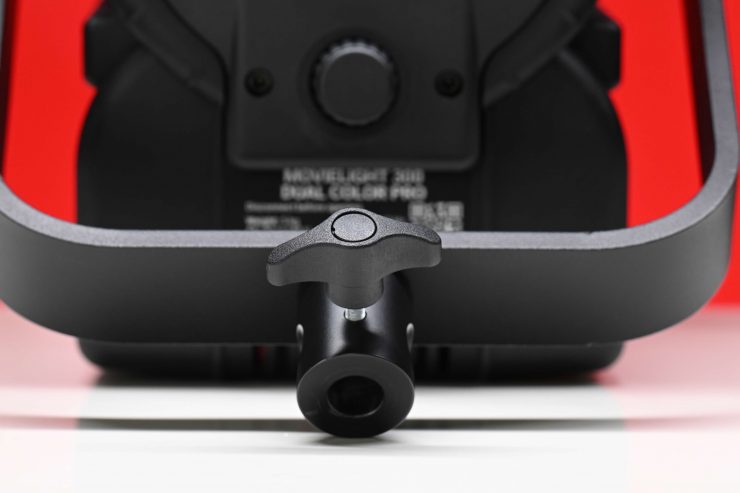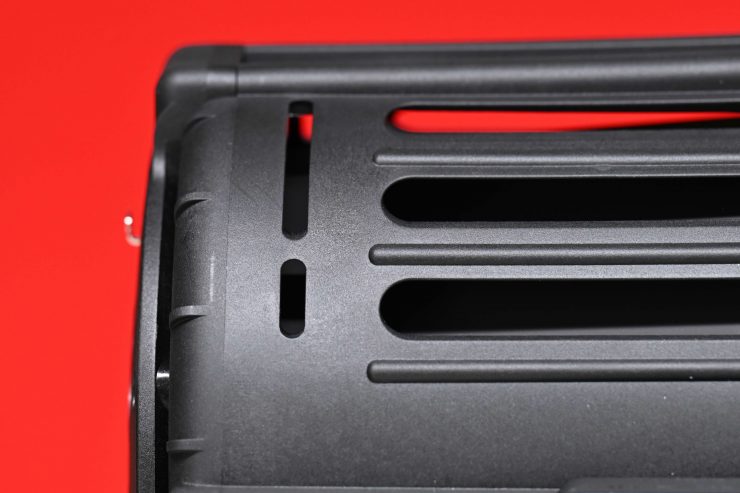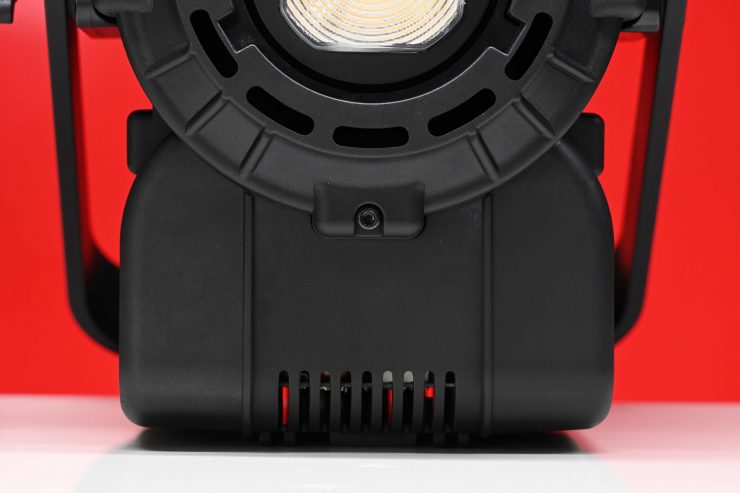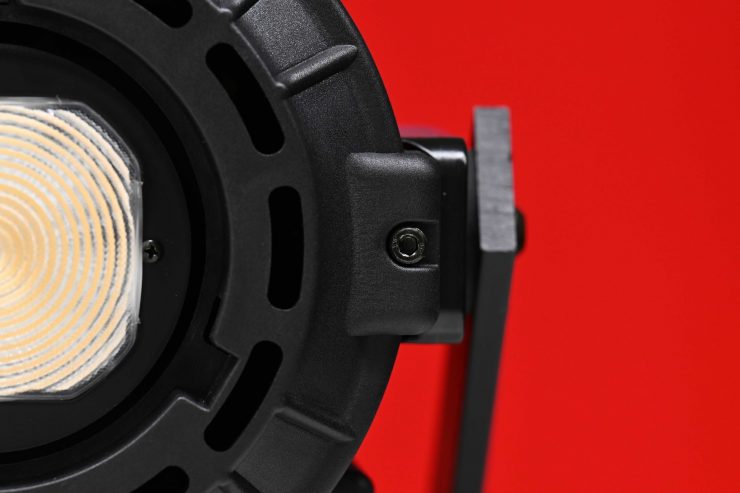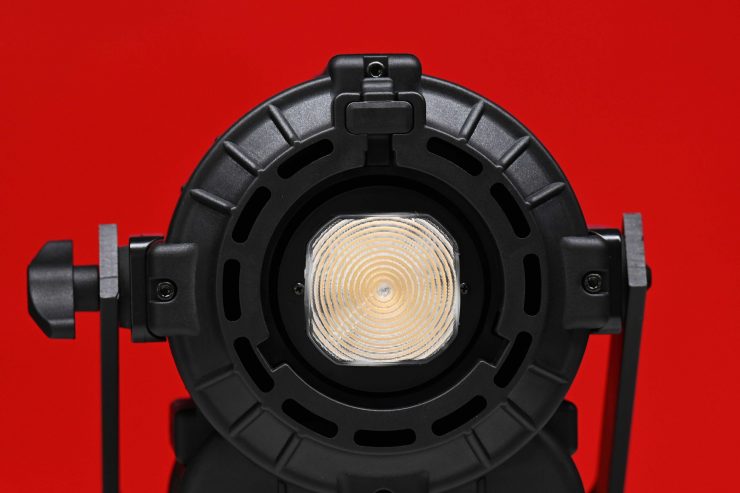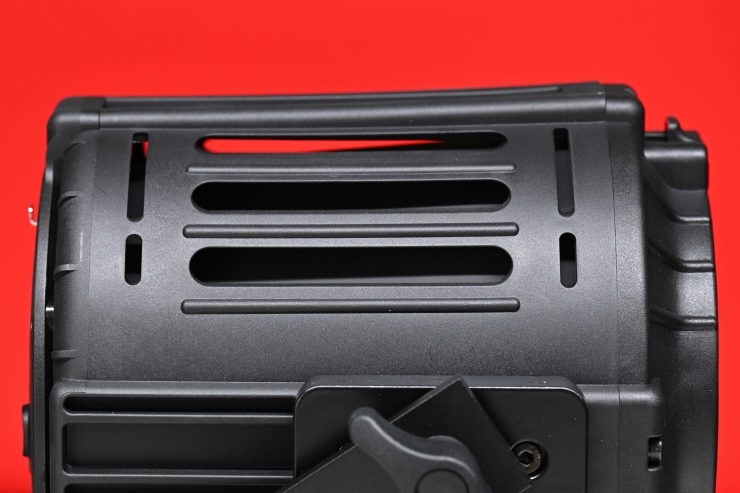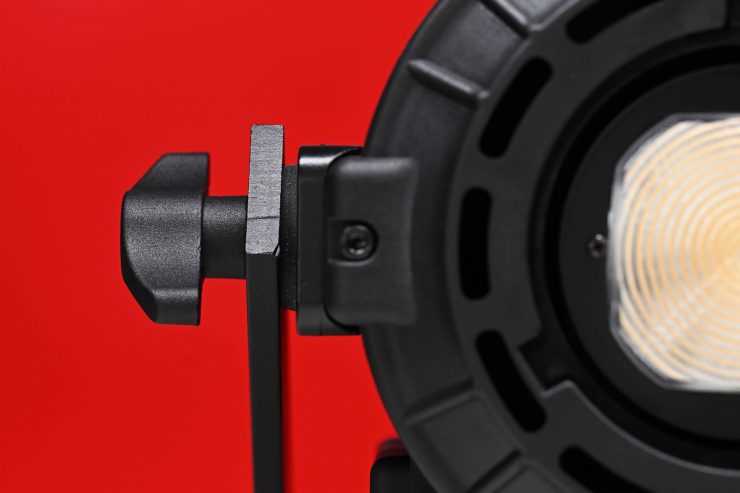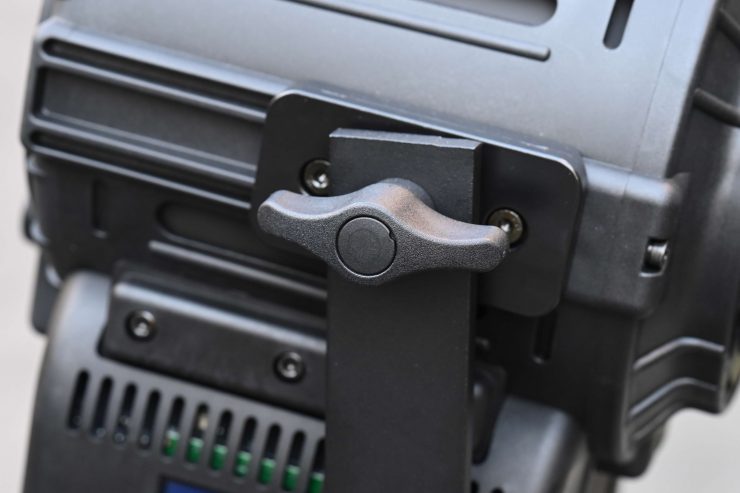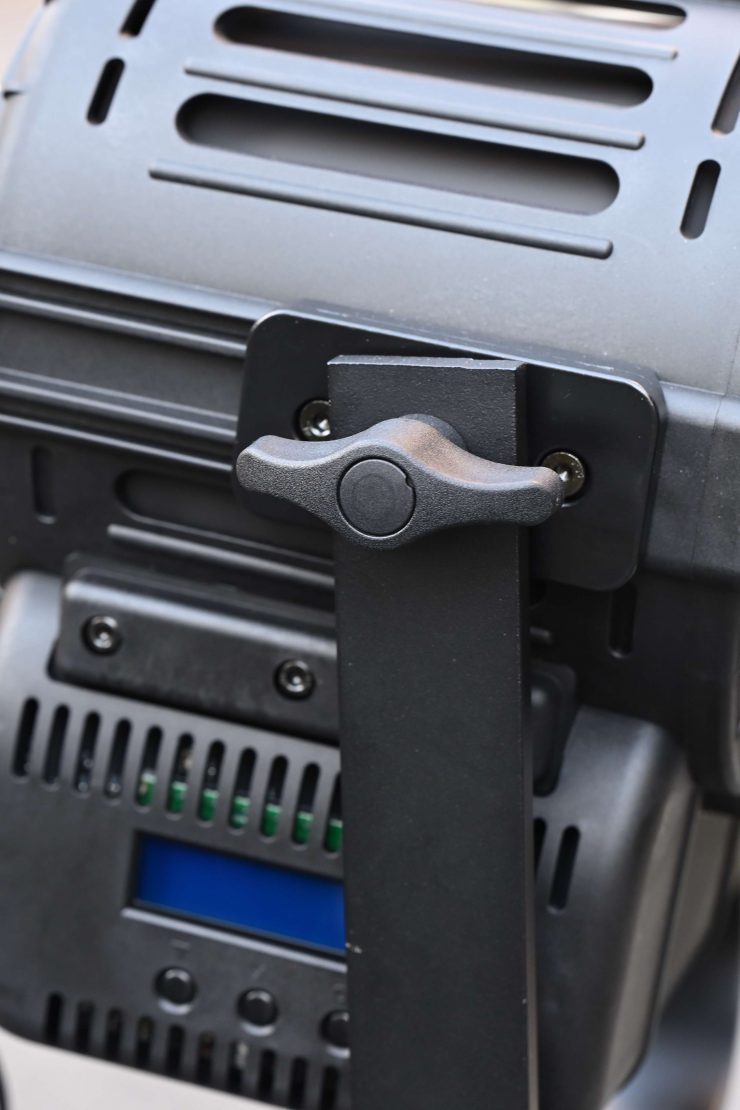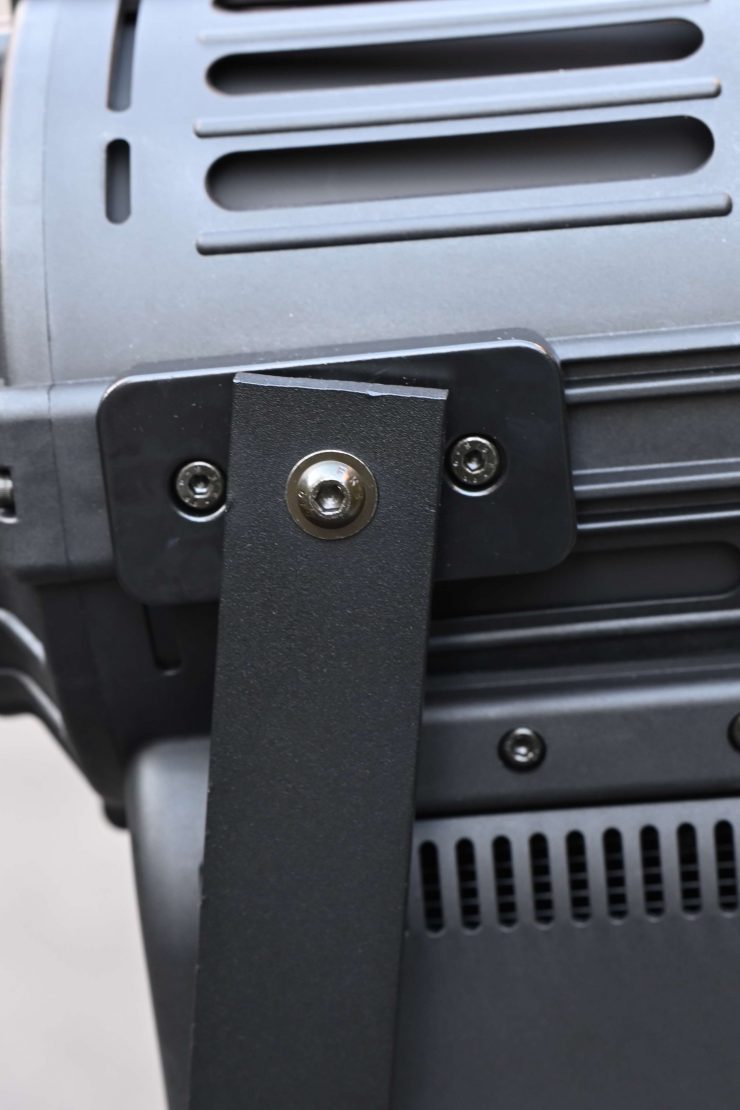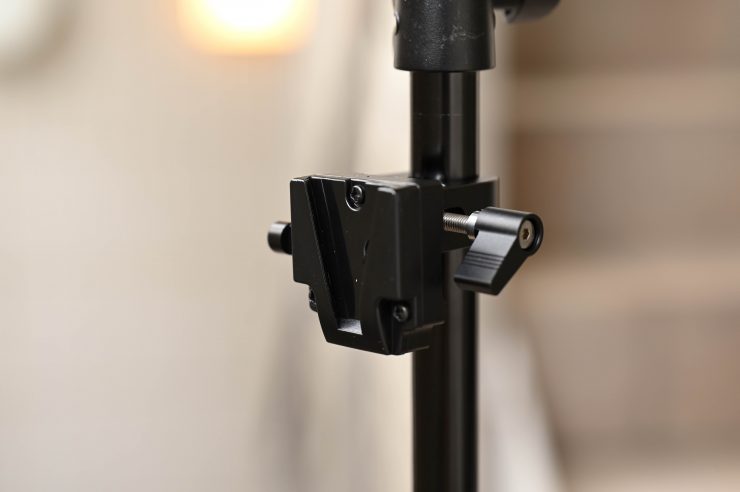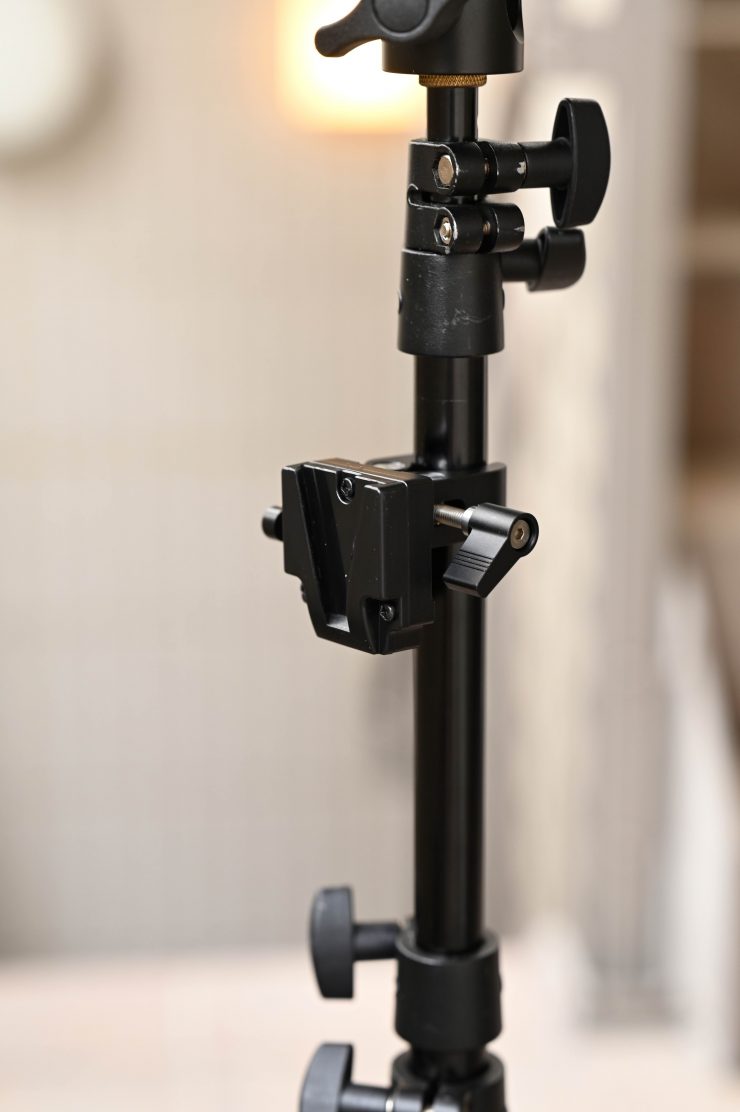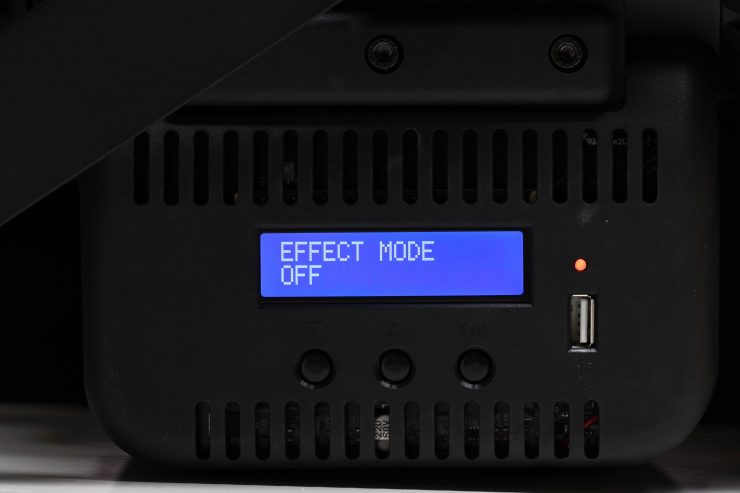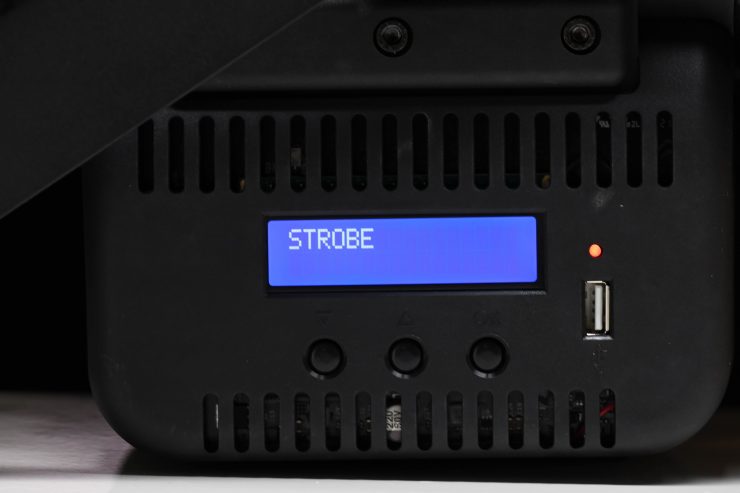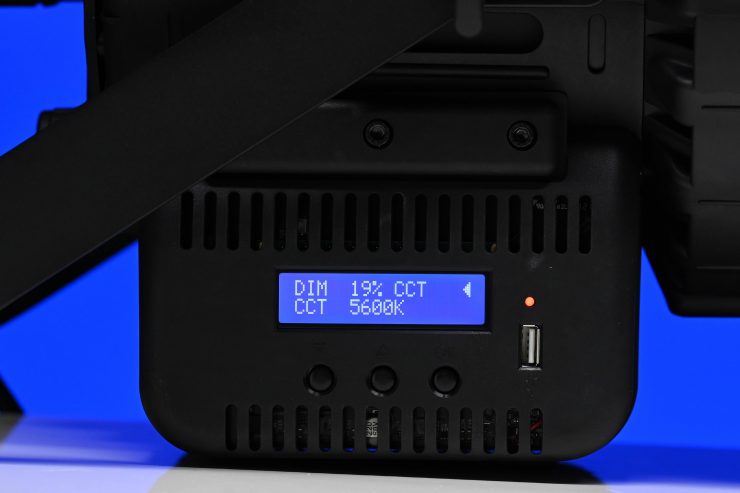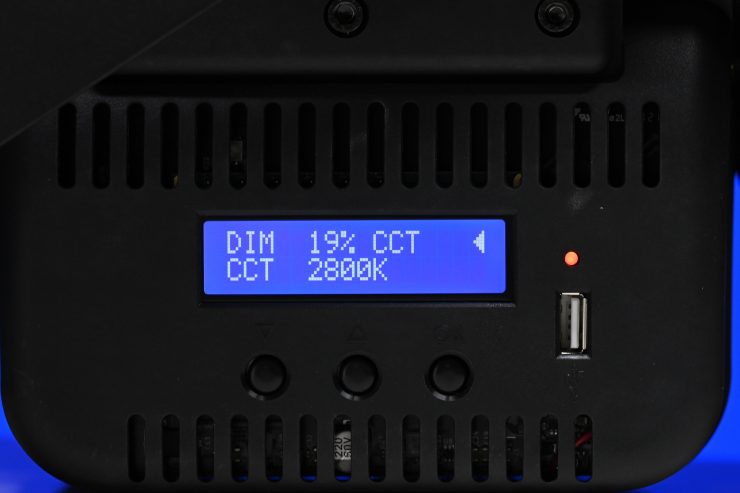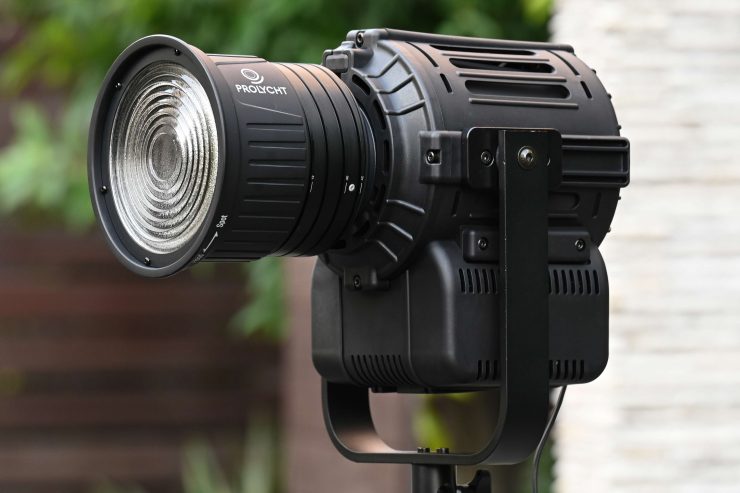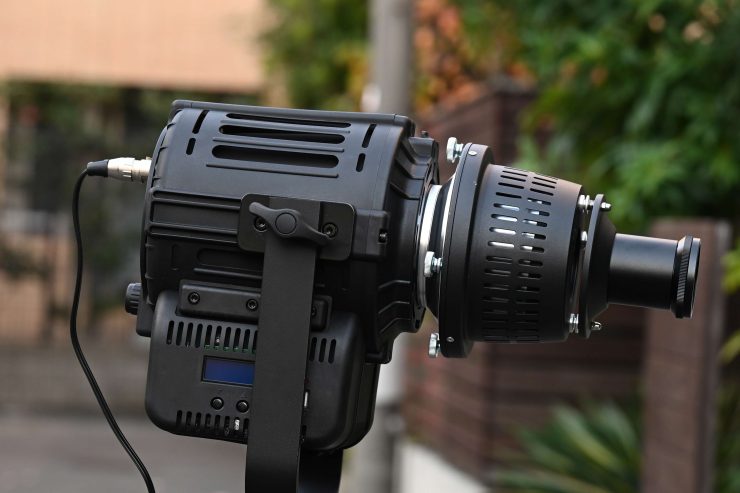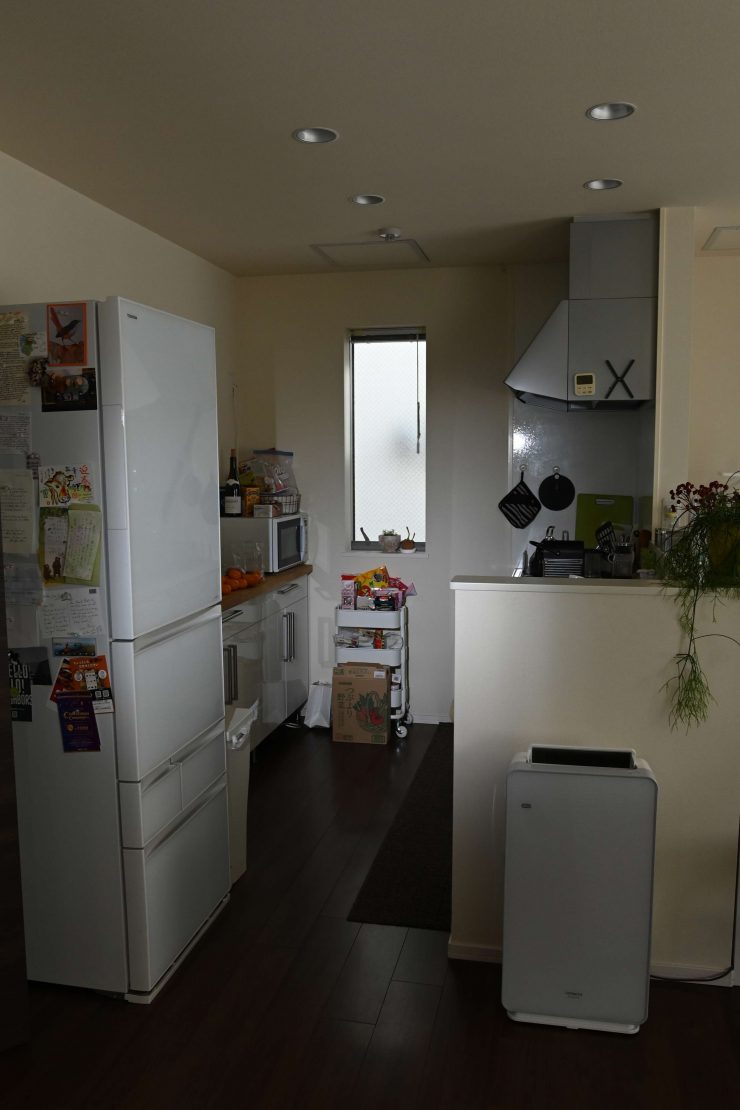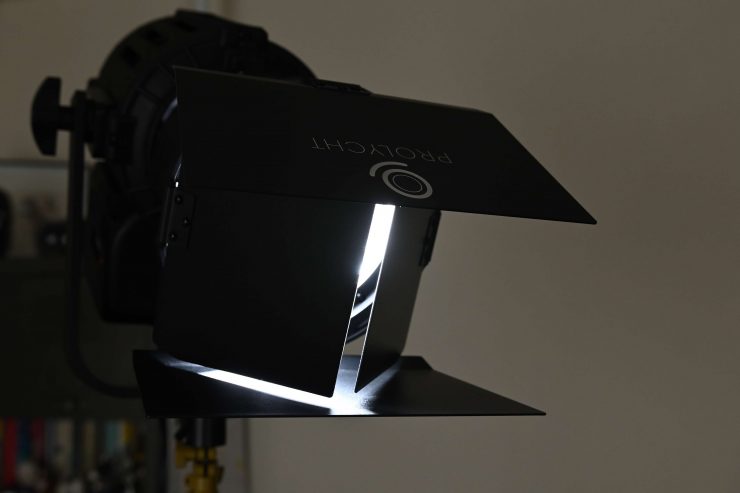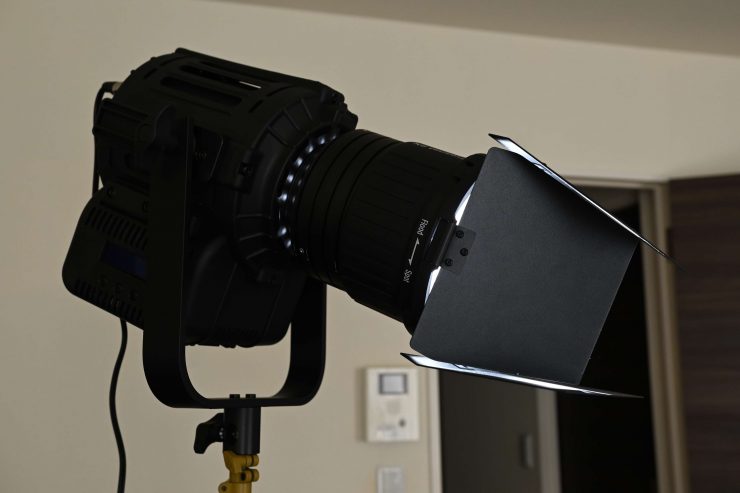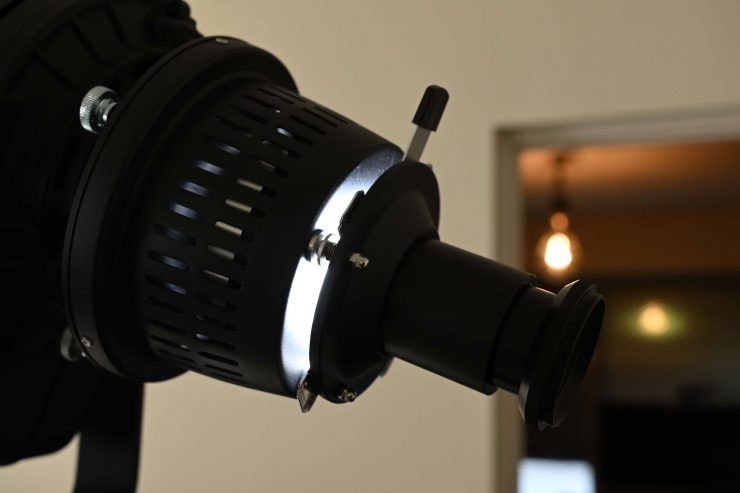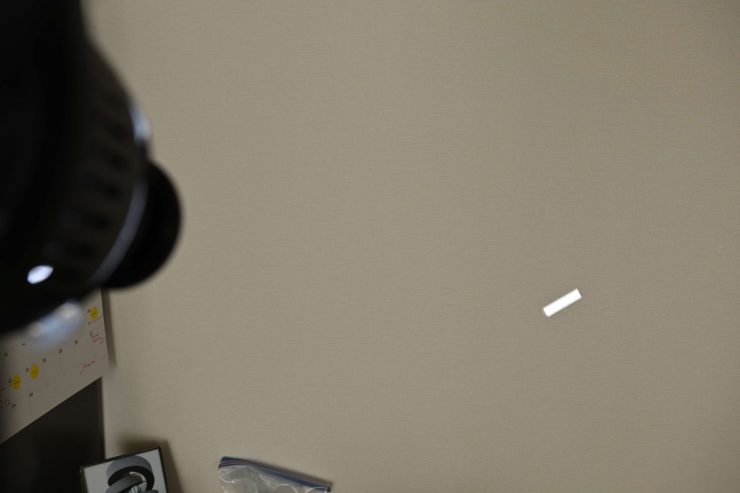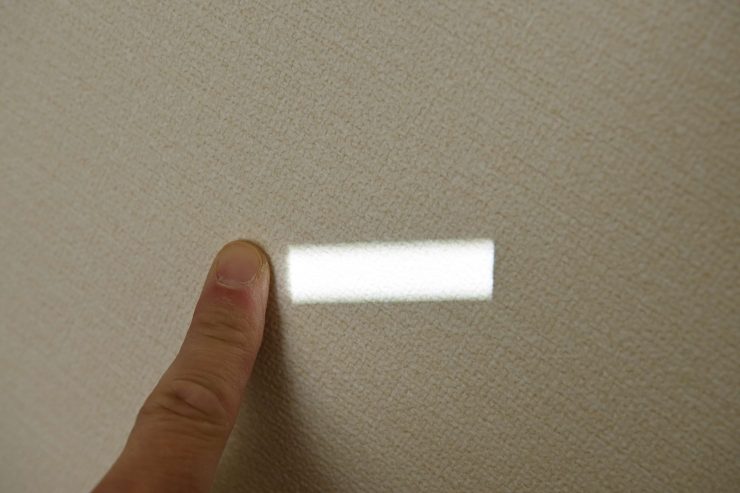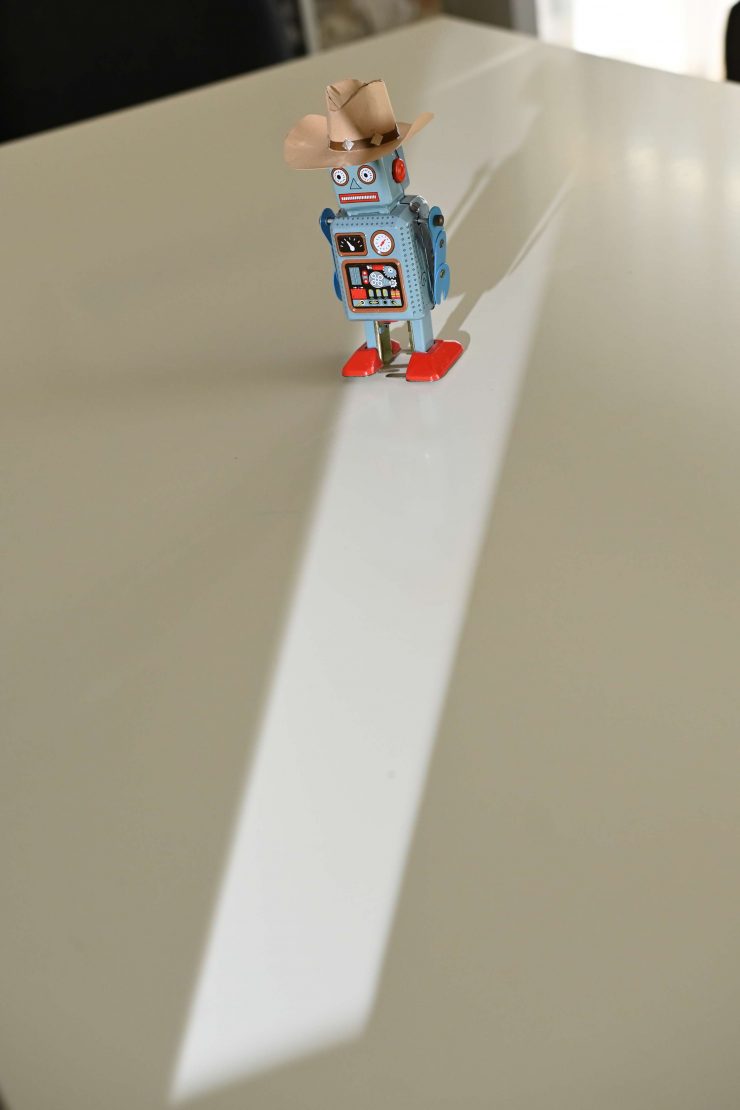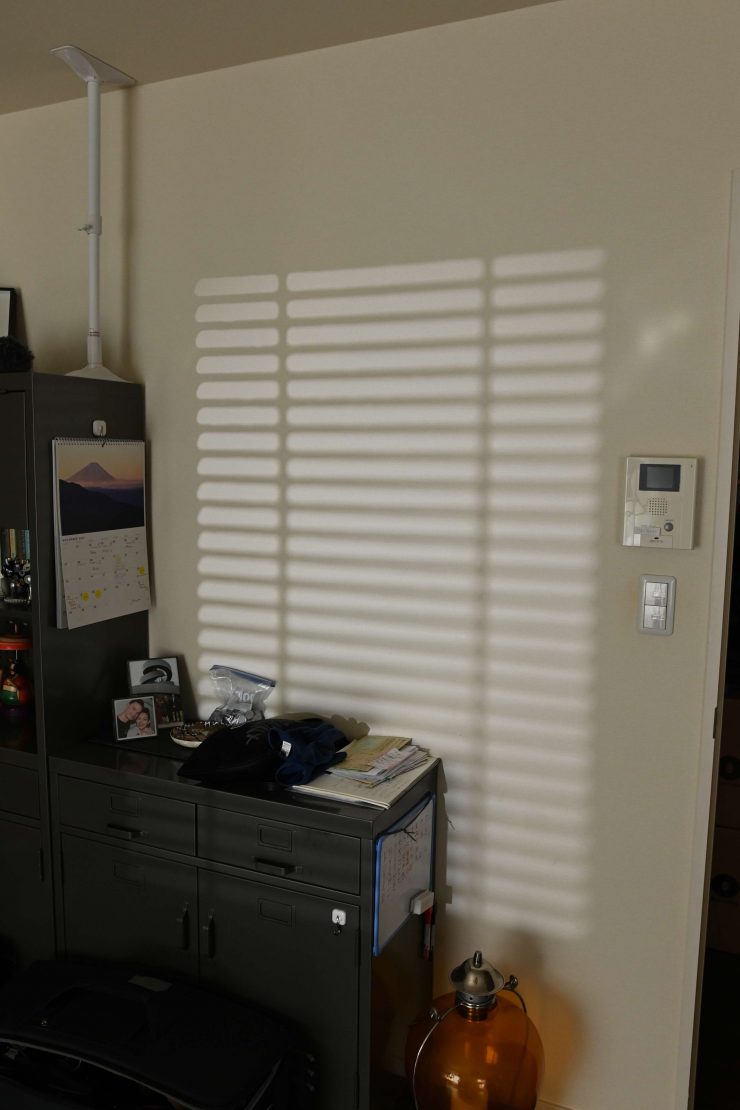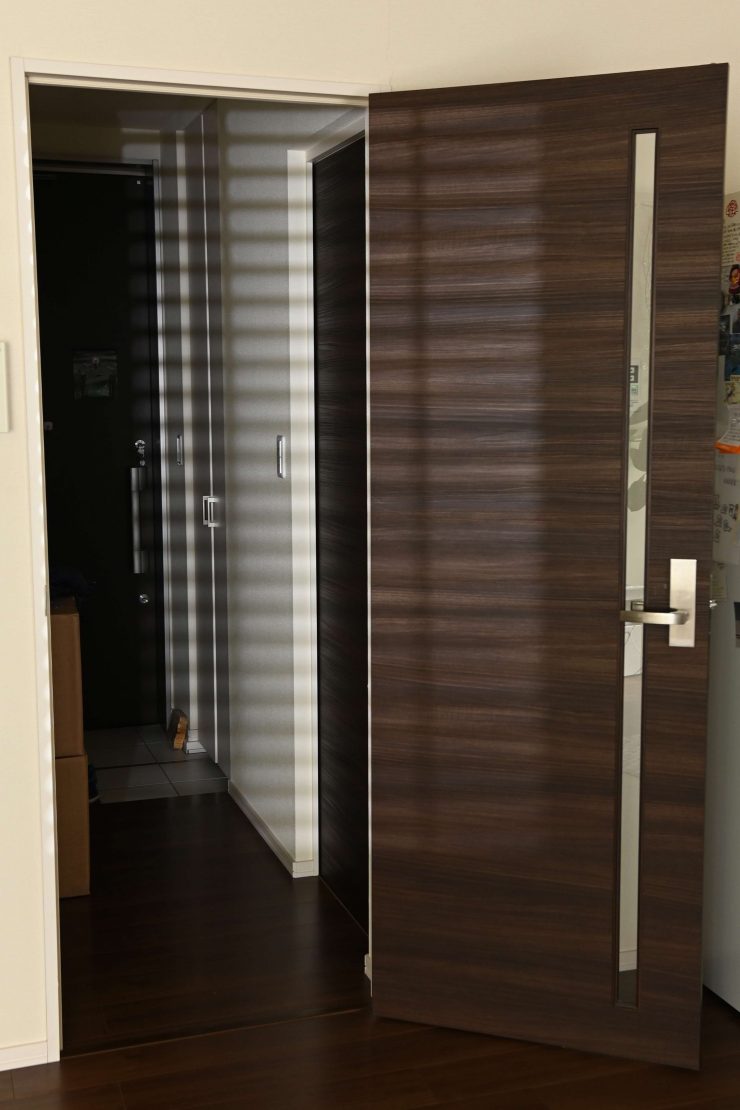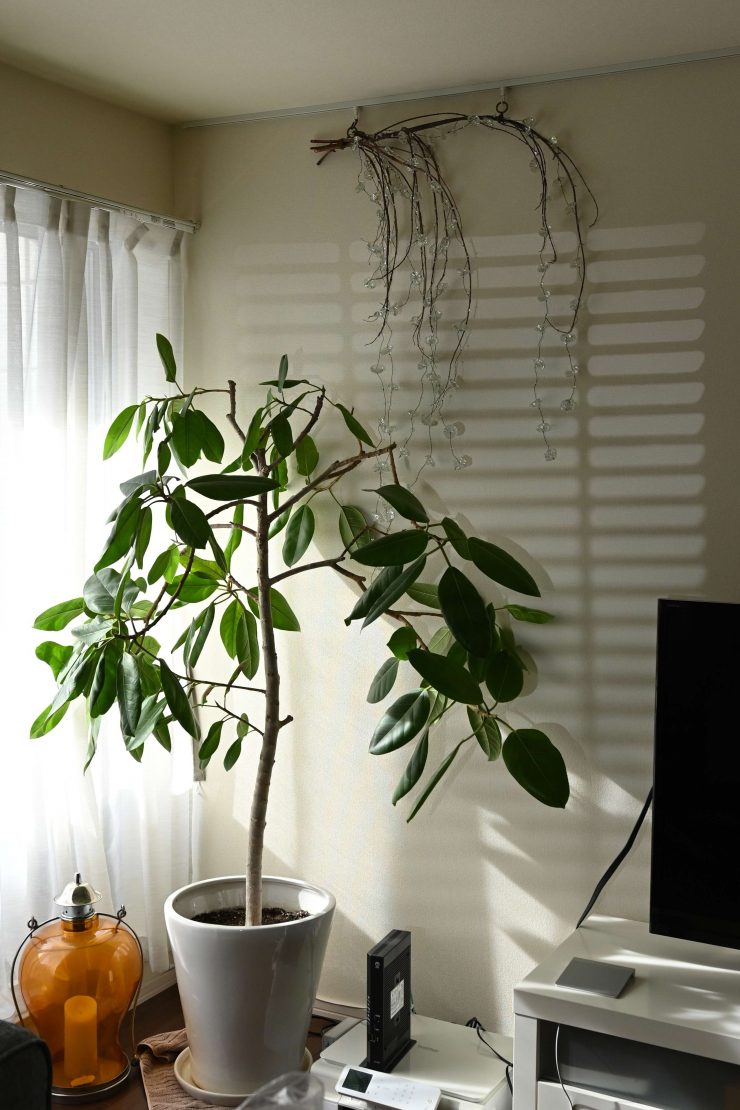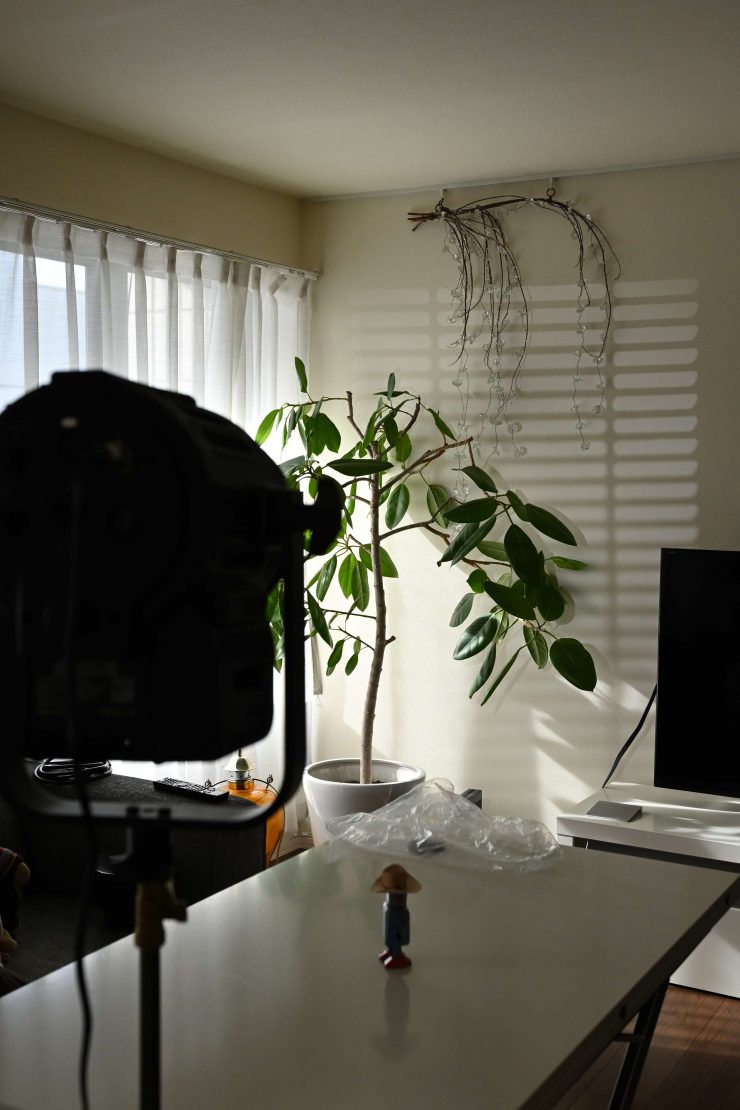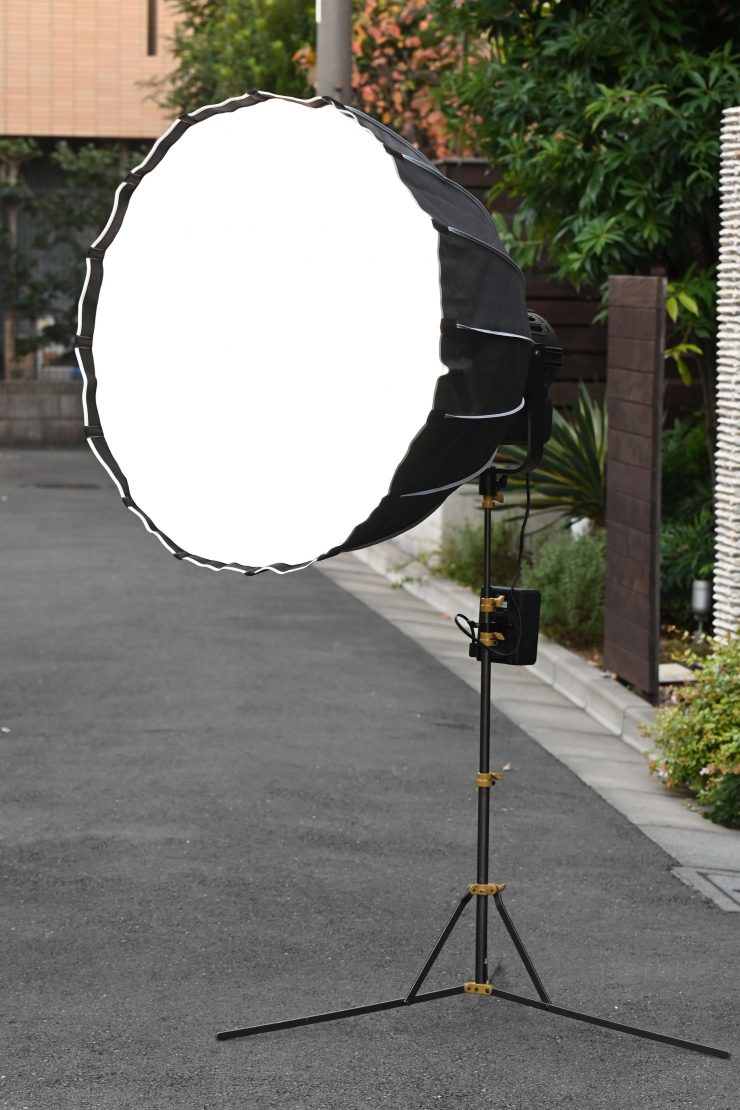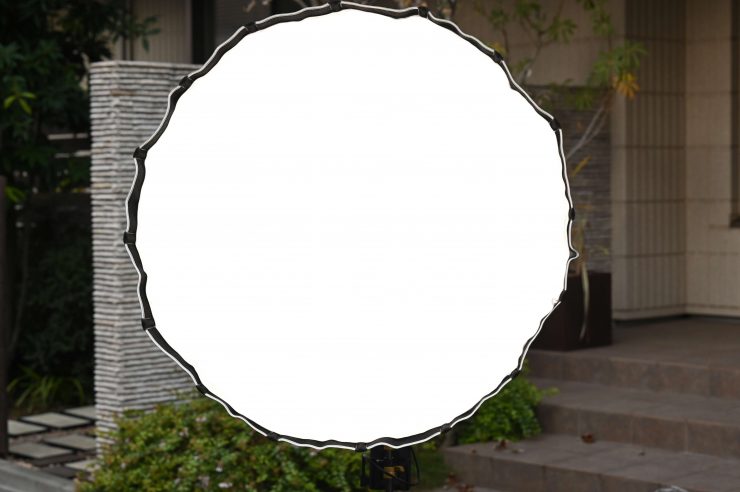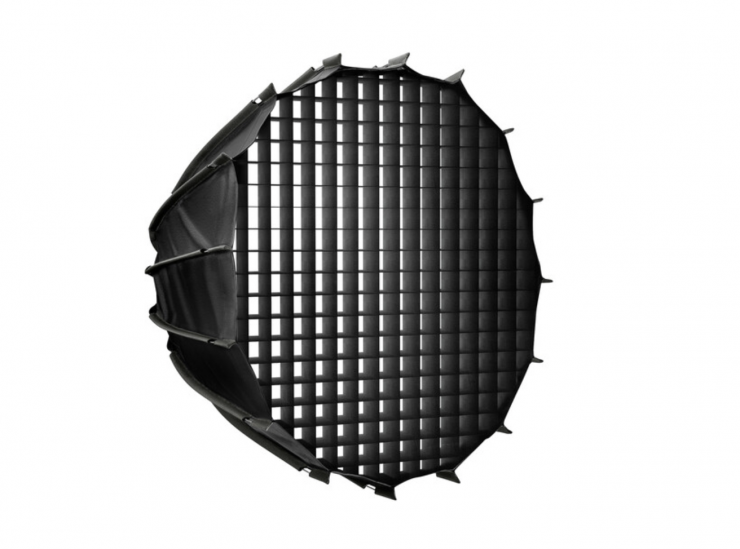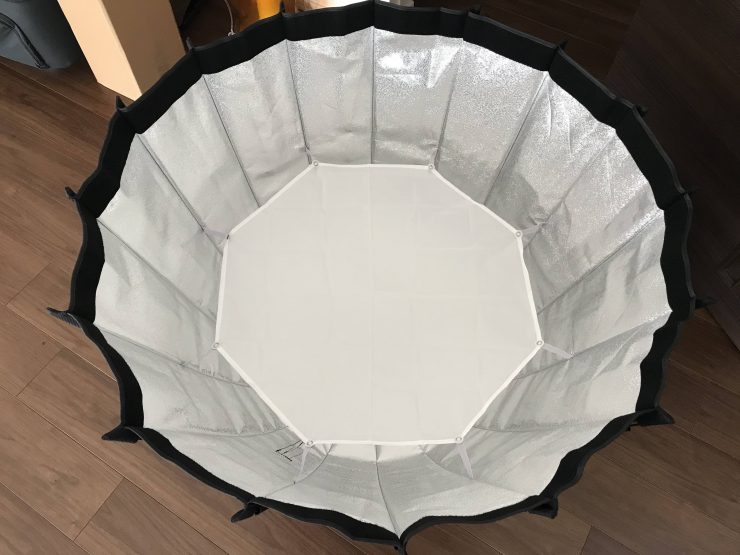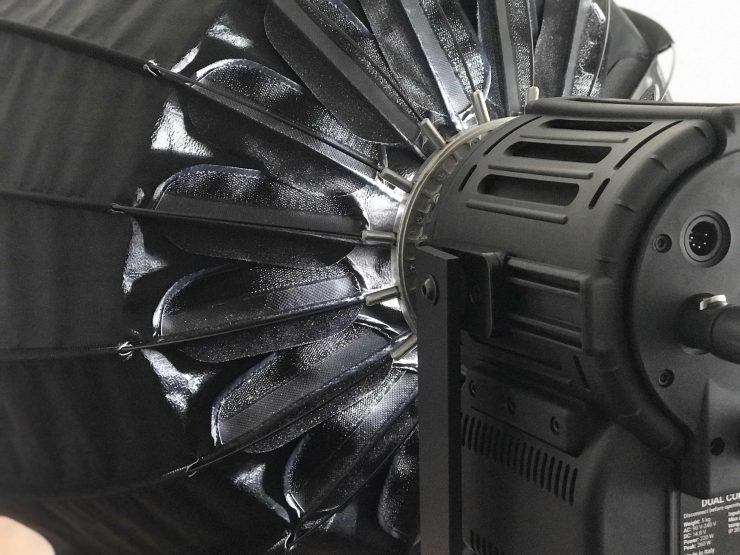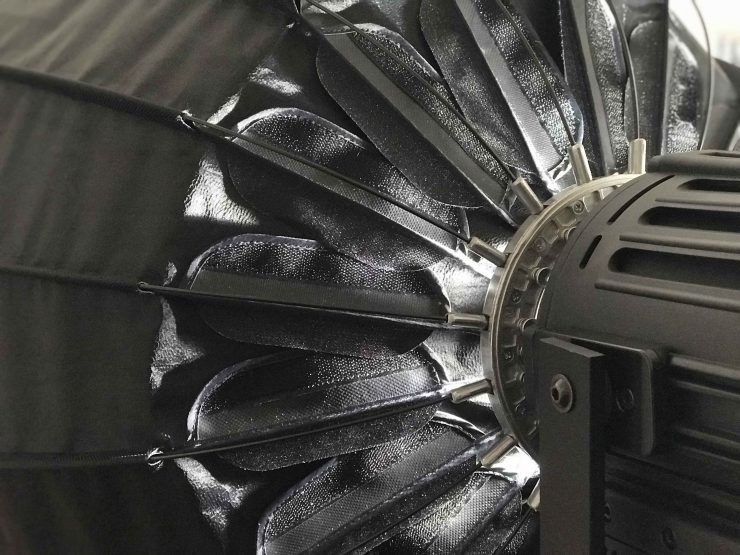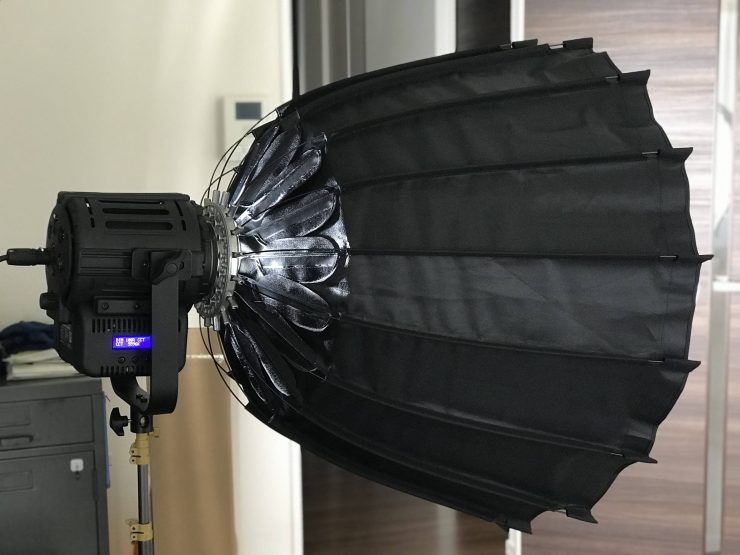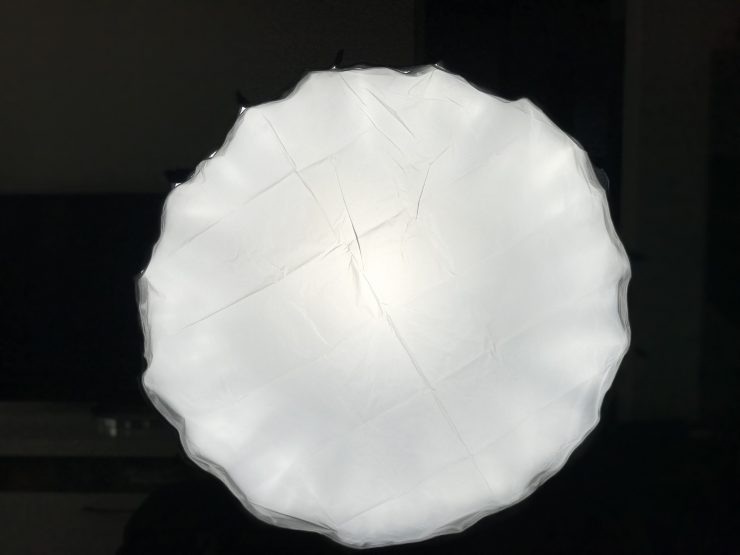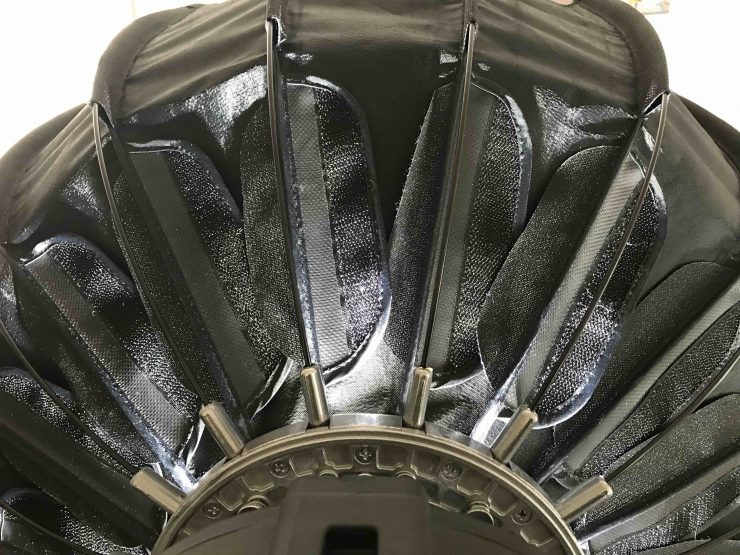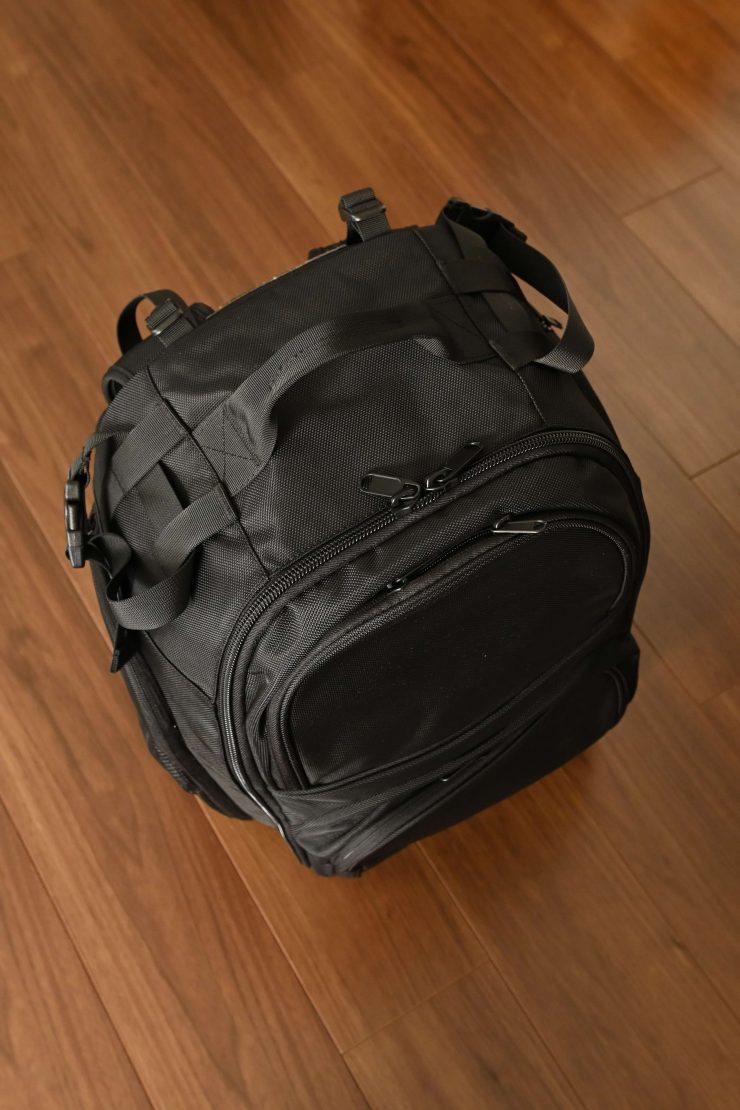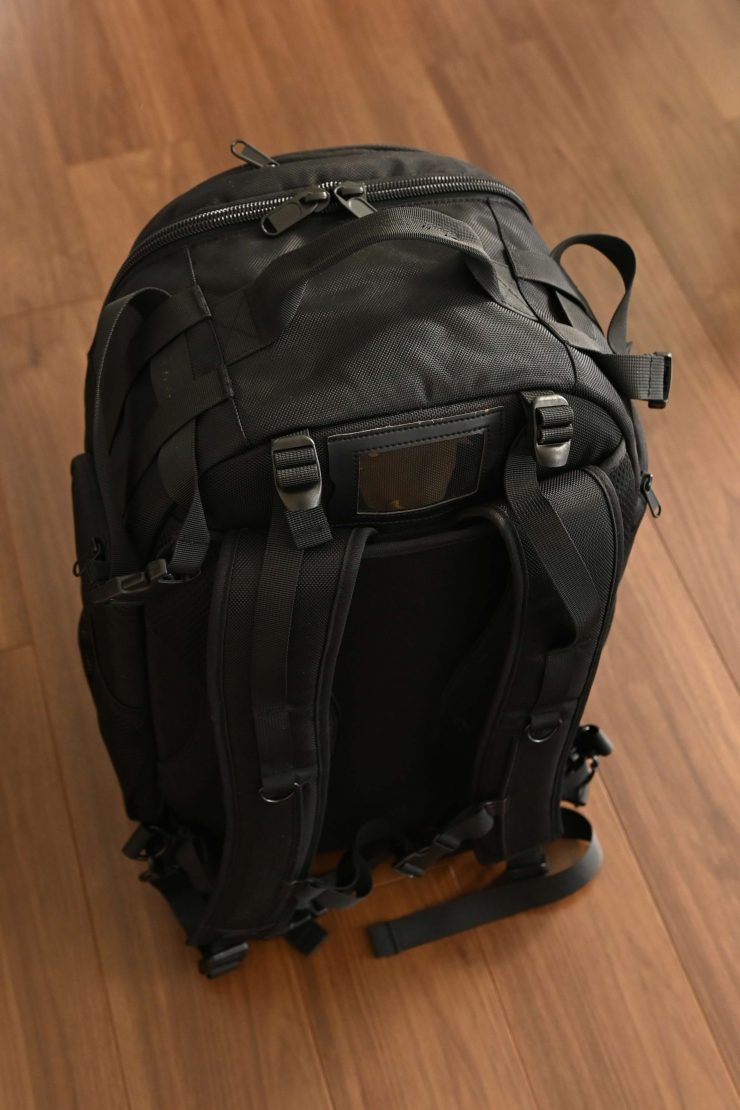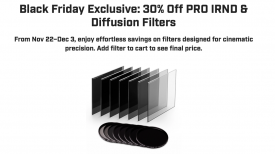
The Lupo Movielight 300 Dual Color PRO is the first model in the new Movielight PRO range. This is the first model in the new Movielight PRO range, however, a new Movielight 600 Dual Color PRO is also planned. Further versions will be coming in 2022.
COB spotlights have become increasingly popular due to their versatility and it comes as no surprise that Lupo now wants a piece of that pie. Lupo has been making affordable, high-quality LED fresnels for many years and they were around way before companies such as Aputure, Forza, and Nanlux appeared.
Lupo has a strong pedigree in making fresnel and high output 1×1 and 2×1 sized panels, but the Movielight PRO range is their first foray into making COB spotlights.
The new Movielight PRO shares a very similar form factor to existing Lupo Dayled LED Fresnels.
Lupo Dayled LED Fresnels are very popular with broadcasters, because they are robustly made, offer a good amount of output, and they can be run via camera batteries.
COB spotlights are becoming increasingly more popular because of their versatility. So, without further ado, let’s get on with the review.
Concept
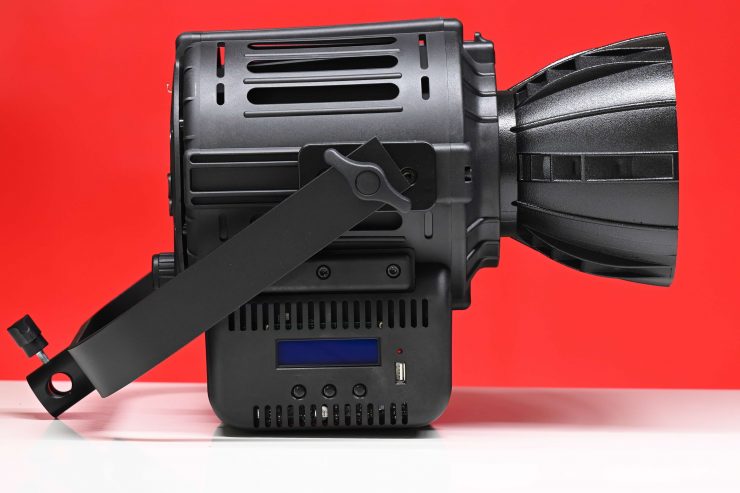
The concept behind the new Movielight PRO range was to make a versatile, well-built, affordable lighting source that could be run off camera batteries and controlled via an app.
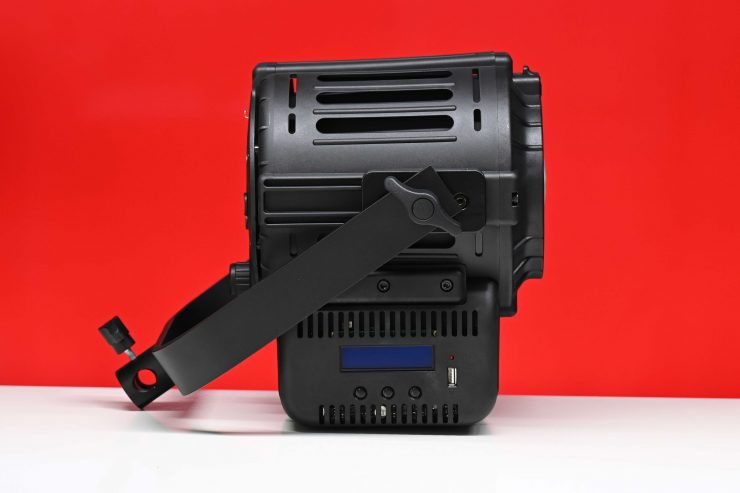
Lupo Movielight 300 Dual Color Pro 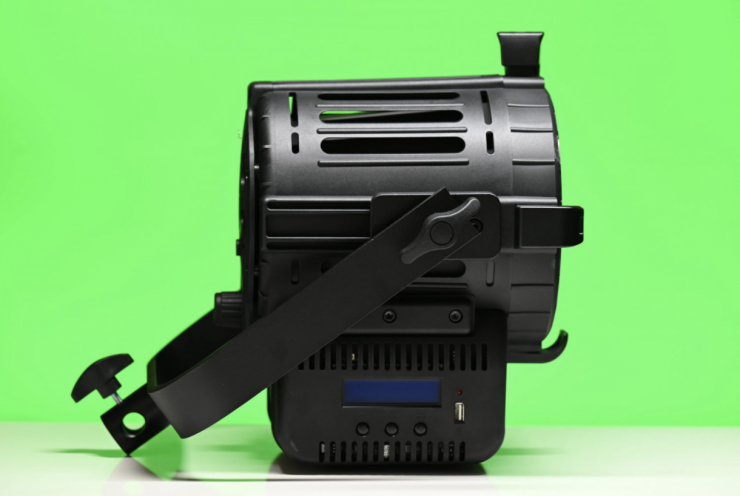
Lupo Dayled 1000 Dual Color PRO
As I already mentioned, the Movielight 300 Dual Color PRO looks very similar to Lupo’s Dayled Dual Color Fresnels.
Despite being an Italian company, Lupo doesn’t try to be overly flamboyant, nor do they make any outrageous marketing claims. Lupo is all about making solid, reliable products for broadcast and film use. A light should be able to stand on its own, and if it is good enough, then it shouldn’t need to be compared against something else. I like that Lupo doesn’t compare its lights to the competition, instead they let their products do the talking.
Quite a few LED lights on the market, including the Movielight 300 Dual Color Pro are using COB technology. COB stands for “Chip On Board” where multiple LED chips are packaged together as one lighting module. The advantage of COB LEDs being multi-chip packaged is that the light-emitting area of a COB LED can contain many times more light sources in the same area that standard LEDs could occupy. This results in a greatly increased lumen output per square inch. The caveat with COB LEDs is that they produce a ton of heat and that heat needs to be effectively dispersed. You also need to diffuse them as they are very bright to look at and unsuitable for directly lighting talent.
Key features
- Bluetooth module inside
- Lupo App control
- Standard Bowens Mount attachment
- Dual Color Version 2800K to 6500K
- 96 CRI and 98 TLCI like other Lupo fixtures
- Different dimming curves
- DMX
- Special effects
- Made out of reinforced technopolymer
Who is Lupo?
Lupo isn’t a new company, they have been around for a very long time. Lupo was founded in 1932 by Carlo Lupo and the company first started making professional photography studio equipment. In their first few decades, production focused mainly on equipment and accessories for professional photography such as enlargers and tripods. At the end of the ‘70s, Lupo was passed on to the second generation and was managed by the founder’s sons, Aldo and Giorgio Lupo, who expanded production and subsequently transferred their headquarters to Collegno, near Turin, where it is still located today. In the ‘90s, it began to focus on the production of professional lighting equipment not only for photographic purposes but also for broadcasting and video environments. Thanks to the experience gained over the following two decades, Lupo became a well-known and appreciated brand in television studios around the world, thus building the foundations of its current success and the widespread distribution of its lighting systems. Since 2010, with Andrea and Carlo Lupo, it has concentrated on the development and production of LED lighting specific to various sectors, particularly television, video, live shows, theatre, and photography.
Build Quality
Lupo lights have always been solidly made. All of its fixtures are made out of reinforced technopolymer. This keeps the weight down, but it also makes the lights very robust for field use. Lupo lights are never going to win any beauty contests, but they are going to last you a long time.
The locking mechanism on the yoke frame is solid and the light won’t move when it is tightened down.

Lupo is using a Powercon power cable on its latest fixtures.
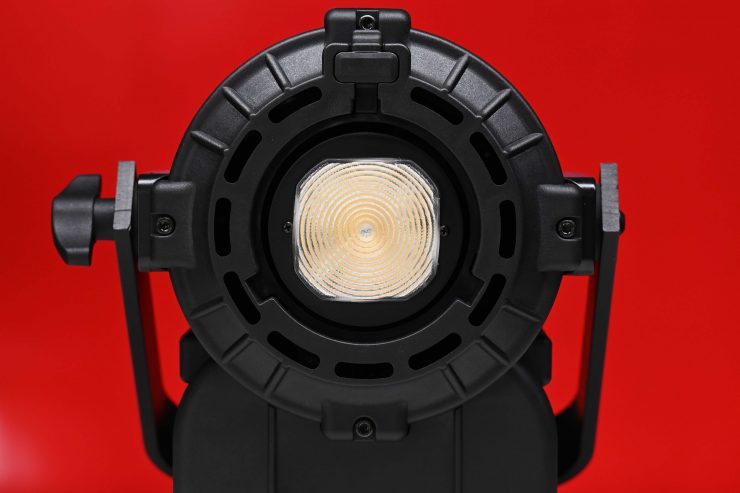
The Bowens mount seems to be nice and robust.
One of the things which are gone, which I miss from the older Lupo Dayled lights, is the handle. I liked the handle because it made carrying the light and taking it off a light stand a lot easier. I would have liked to have seen a handle on the Movielight 300 Dual Color PRO.
Size & Weight
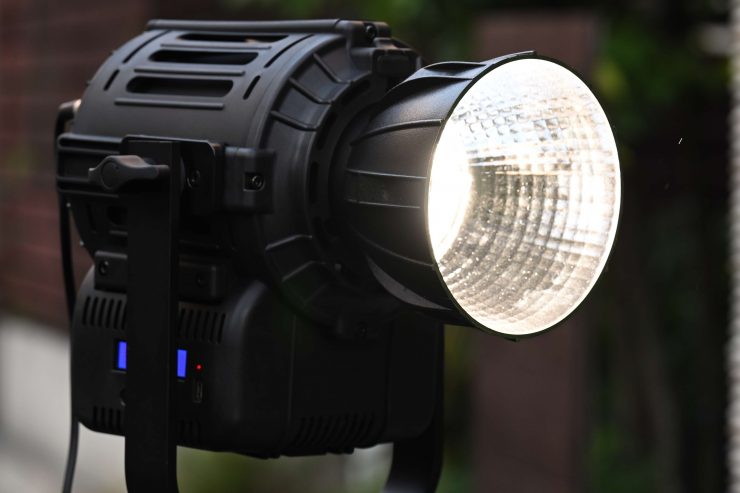
The Lupo Movielight 300 Dual Color PRO weighs in at 5kg / 11lb. What you clearly need to remember is this is a self-contained light and the power supply is built-in the fixture so there is no additional power ballast that needs to be connected. This does make it very quick to set up and use.
So how does this weight compare to some other similar fixtures?
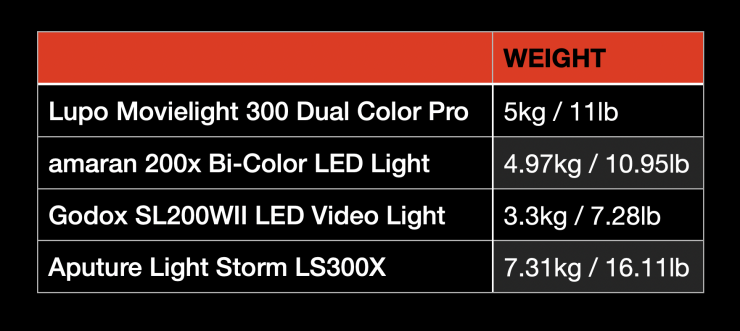
As you can see, the weight of the Lupo is very similar to that of the amaran 200x, but quite a bit lighter than the Aputure 300X.
Mounting
The Lupo Movielight 300 Dual Color PRO utilizes a simple yoke frame that has one lock-off mechanism.
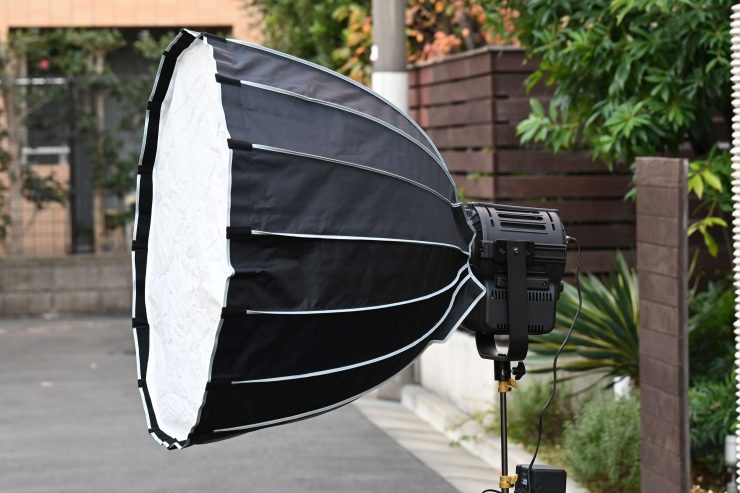
The yoke frame allows for a fair bit of movement, but it will get reduced if you are using a large softbox.
Power Draw
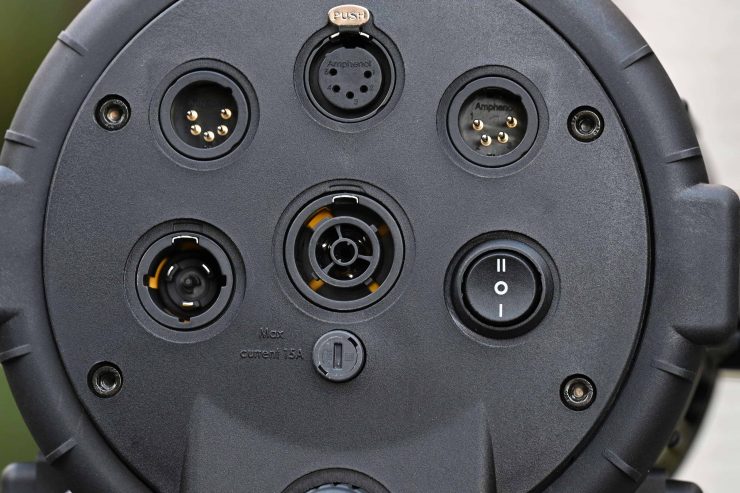
The Movielight 300 Dual Color PRO uses a 200W COB LED spotlight and it has a maximum power draw of 260W.
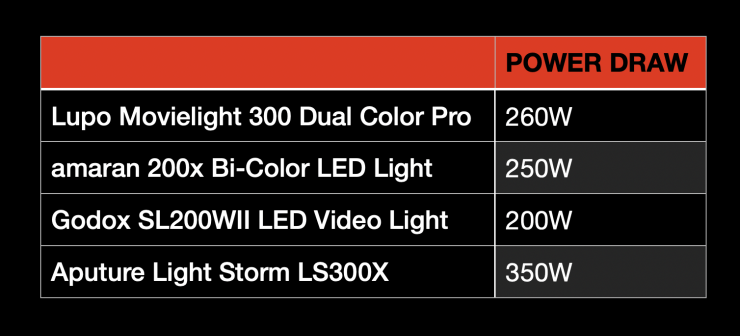
Above you can see how the power draw compares to some other similar fixtures.
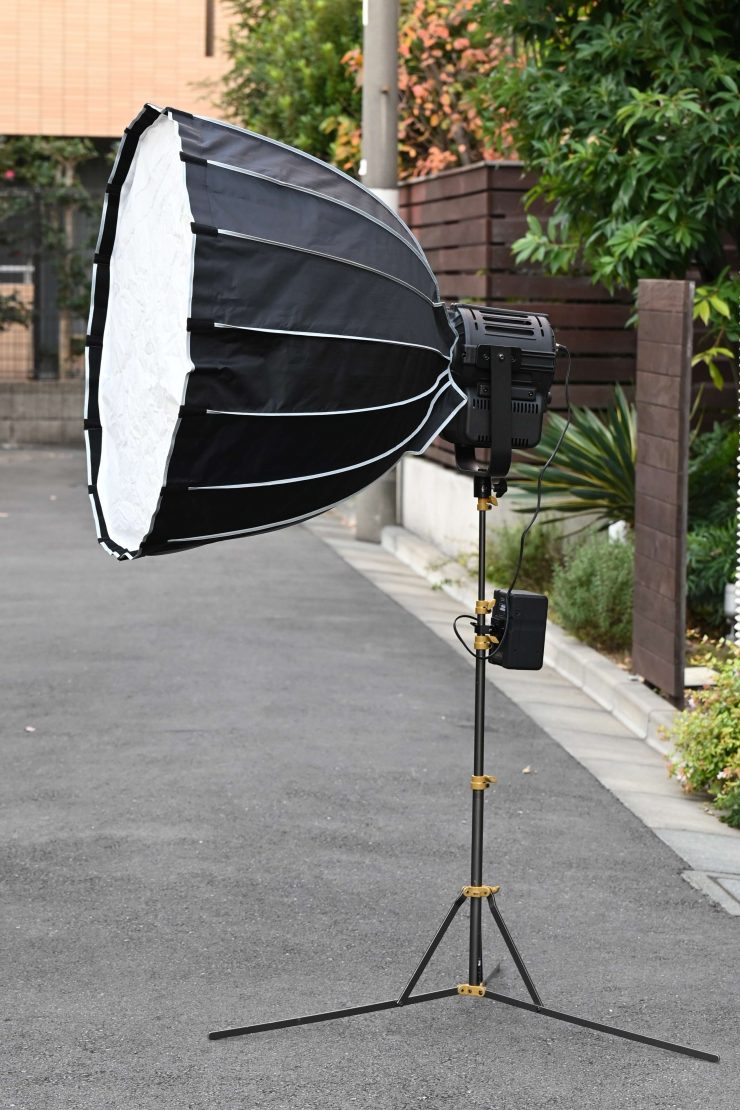
The light can also be run off a V-lock battery using an optional battery plate. This optional V-Mount Clamp allows you to attach a V-Mount battery to a rail, tripod leg, table, and other objects using a heavy-duty metal clamp. The battery’s contacts and connectors remain accessible.
The clamp jaws can open up to 35 mm wide. It has dimensions of approximately 55 x 60 x 44 mm (2.2 x 2.8 x 1.7 in) and it weighs 105 g (0.23 lb). This is a nice little accessory, but it does mean you have to use a V-lock battery that has a D-tap, as it is just a battery clamp and not a battery plate.
Layout & Controls
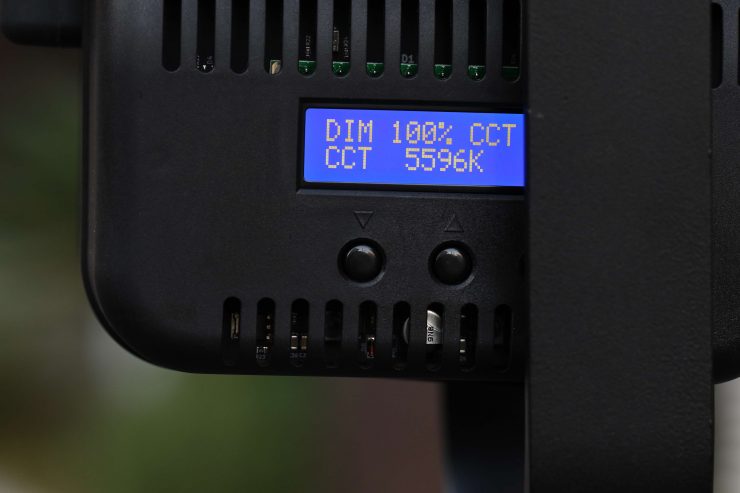
The light features very basic controls and for the most part, it is fairly easy to operate. Once you have to get into the menus it does become more tedious.
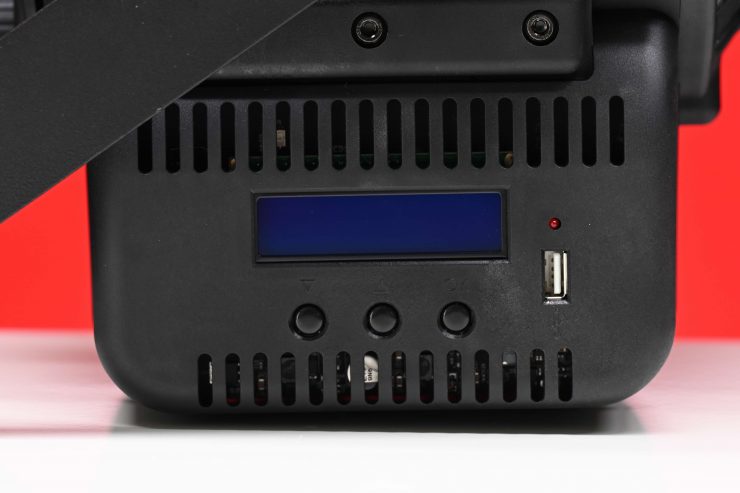
On the side of the light, you will find a small LCD display and three buttons. These buttons allow you to increase/decrease the intensity and Kelvin color temperature as well as access a basic menu.
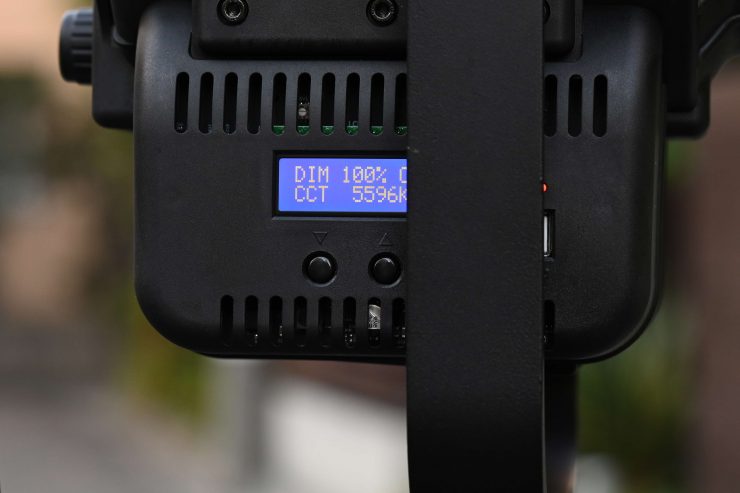
My only complaint is that the controls are hard to reach when you have the fixture on a light stand in a horizontal position because they are obscured by the yoke frame. I would have preferred to have seen these controls on the back of the fixture.
I really do wish that Lupo would update its operating system, it is starting to feel very old and antiquated.
Now, there is also a very basic effects menu you can access where you can choose from:
- TELEVISION
- STROBE
- PAPARAZZI
- LIGHTNING
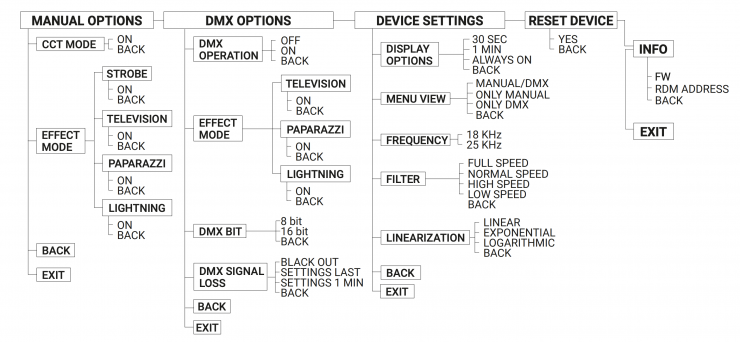
Above you can see a full diagram of all of the available options that are accessible in the menu.
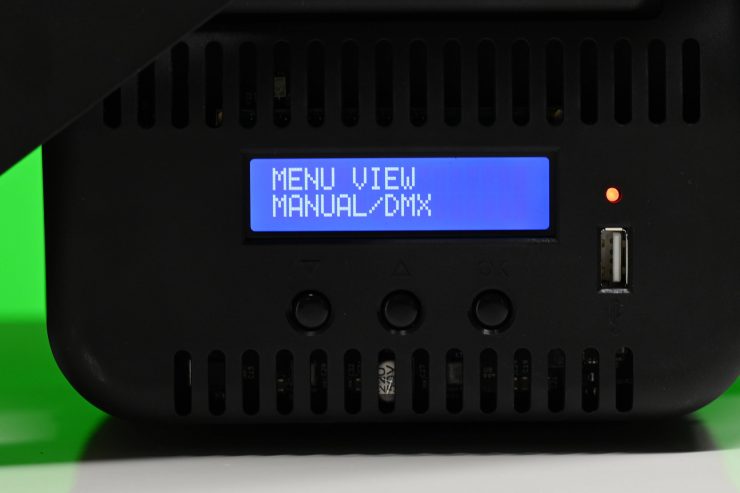
The light also has full DMX capabilities as it includes both a DMX Input and a DMX Through.
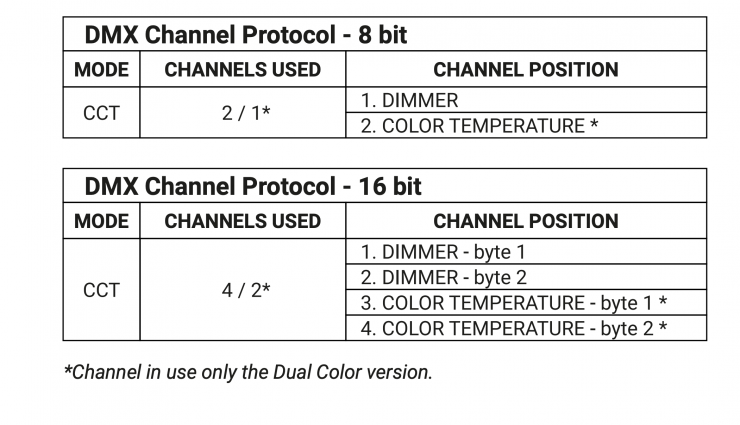
Above you can see the DMX capabilities.
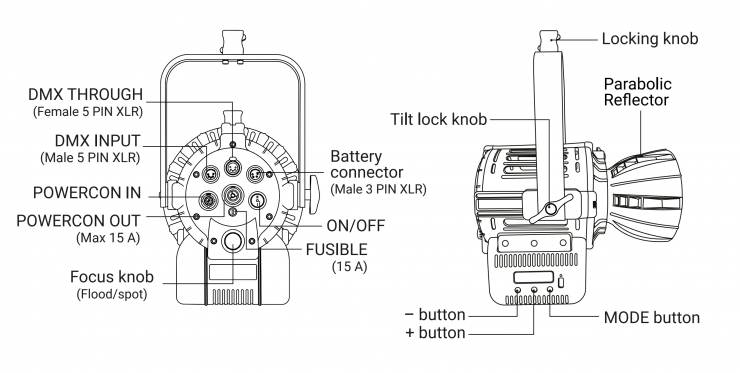
Above you can see where everything is located on the light.
CCT Range
The Movielight 300 Dual Color PRO is Kelvin color temperature adjustable from 2800K to 6500K. You can change the Kelvin temperature in increments as little as 1 degree. This allows for very finite control.
Beam Angle
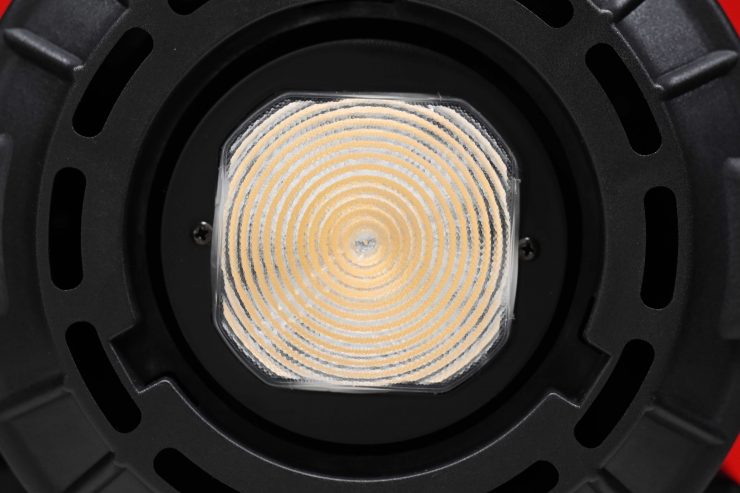
The light has a beam angle of 85 degrees which is slightly narrower than most other similar lights. Lupo’s research indicated that these type of COB spotlights are not being used for illuminating a wall or a green screen, therefore, a lot of the light coming out of a larger COB is wasted and doesn’t go where users want. Most users of lights like these almost never use them open face, instead, they use them with lighting modifiers. Therefore a slightly narrower beam angle does make a lot of sense.
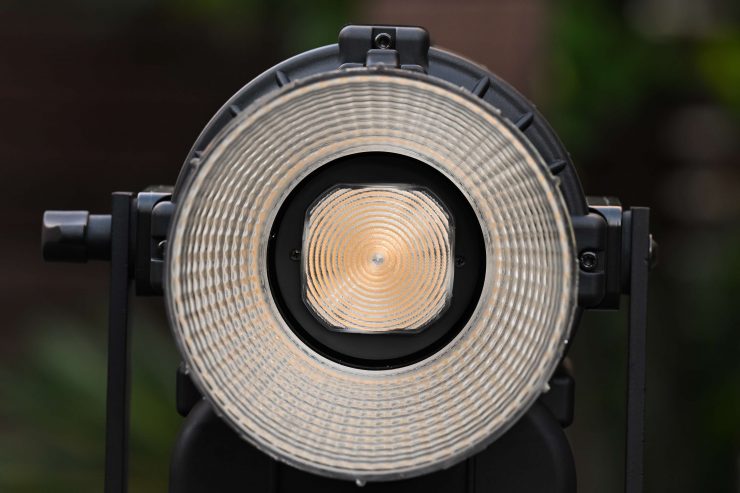
The parabolic reflector that comes with the light is 55 degrees.
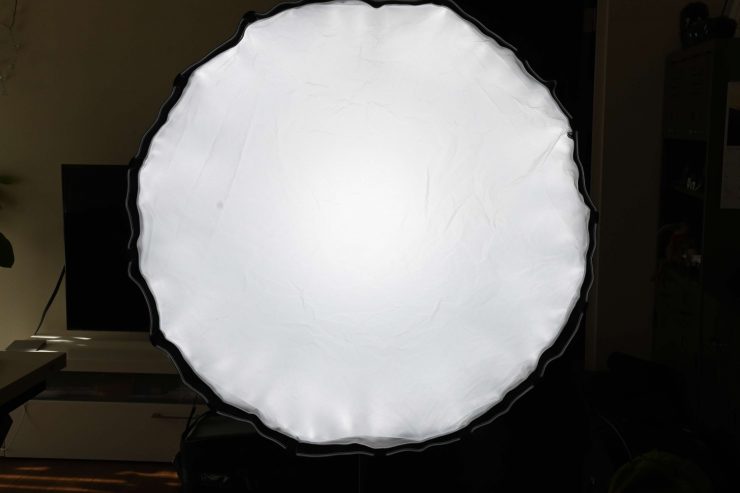
I found that because of the 85-degree beam angle when using the fixture open face, the light doesn’t quite fill up a large softbox. While it still does a decent job, there is going to be a bit of fall off out towards the edges of a softbox.
Whether this is a potential issue or not depends on how and what you would be using the light for. I personally quite liked the fall-off I was getting as often large parabolic softboxes need a honeycomb grid, or to be heavily flagged because of how broad the spread of light is.
Speaking of softboxes, I also got the chance to test out Lupo’s new Dome Pro parabolic softbox. This is really well made, and one of the better Bowens mount softboxes I have personally come across.
The Dome Pro works really well and I highly recommend it if you are going to buy a Movielight 300 Dual Color PRO.
Bowens Mount
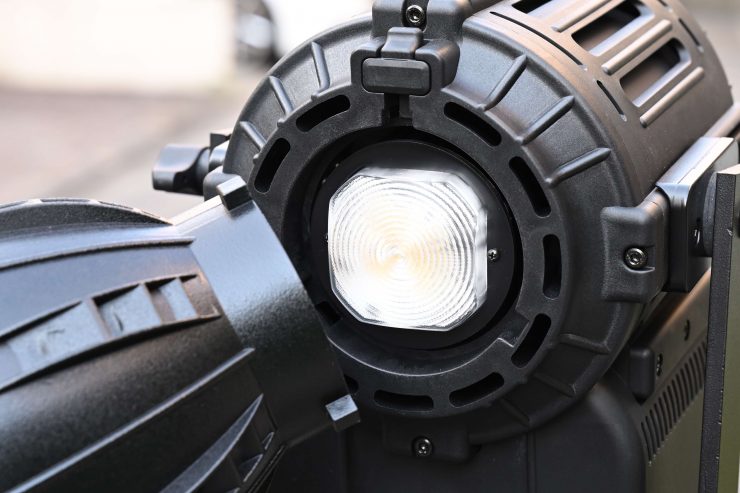
This is the first-ever fixture from Lupo to feature a Bowens mount. The nice aspect of a Bowens Mount is that there is a wide array of affordable lighting modifiers you can choose from.
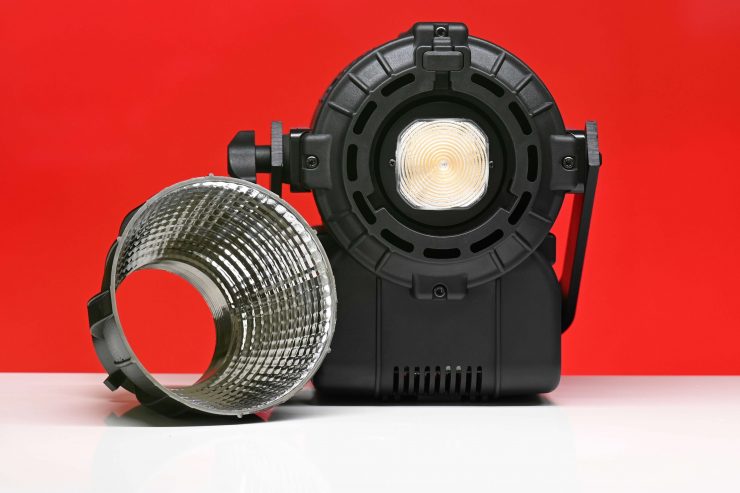
I was curious to see how well some existing Bowens mount lighting modifiers I had worked on the Movielight 300 Dual Color PRO.
I tried using the Prolycht 2x Fresnel that is designed for the Orion 300 FS, and it seemed to work reasonably well. As did the Prolycht Projection lens kit.
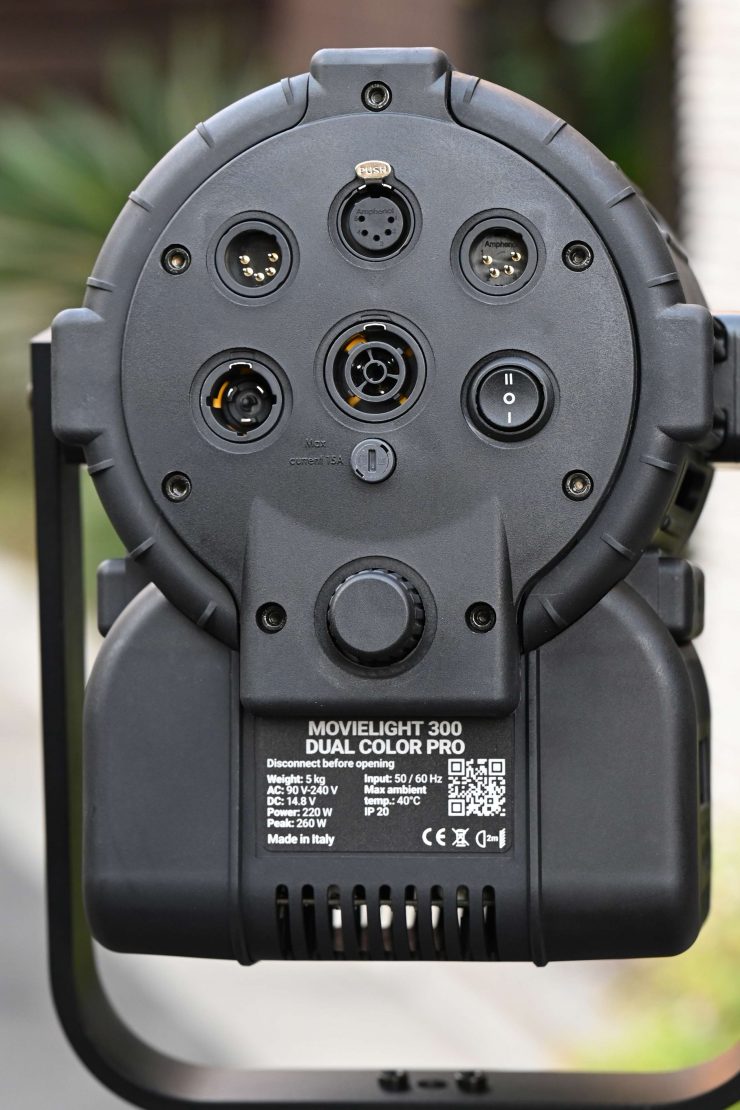
On the back of the Movielight 300 Dual Color PRO, there is actually an adjustment knob. This actually allows you to move the LED array backward or forwards a tiny bit depending on the type of lighting modifier you are using.
Fan Noise
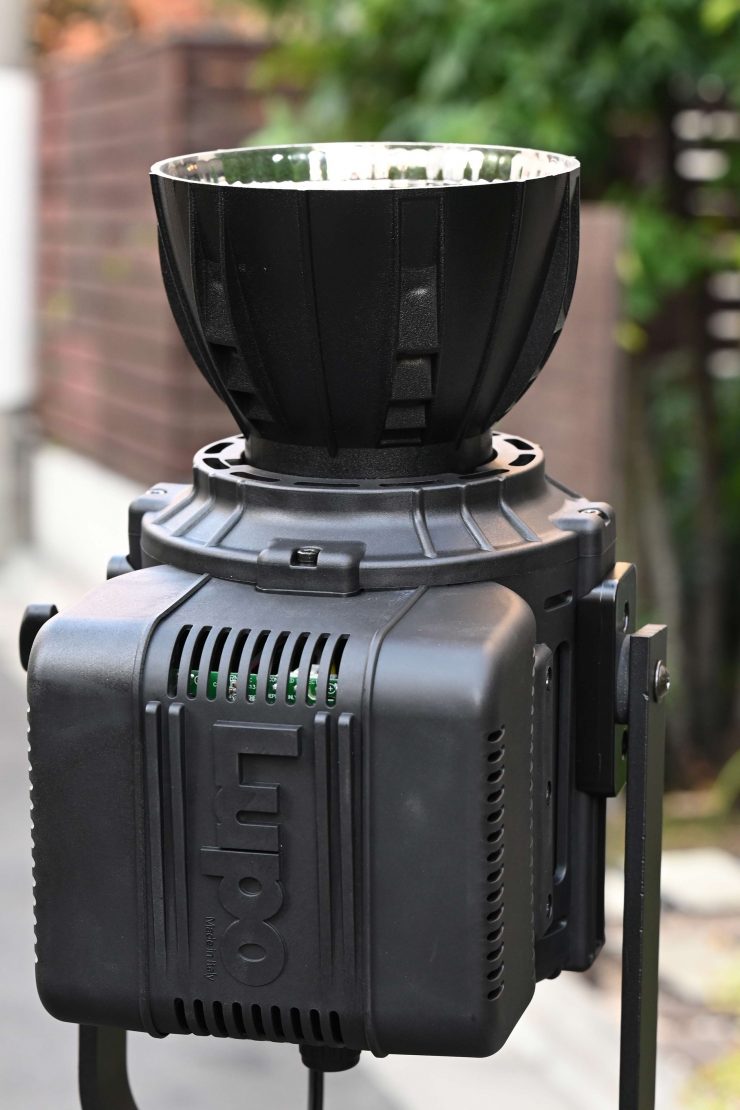
The light does have an in-built fan. You can’t adjust this fan in any way. It is audible, but I found that it wasn’t loud enough to hinder use in a quiet environment.
Bluetooth Control
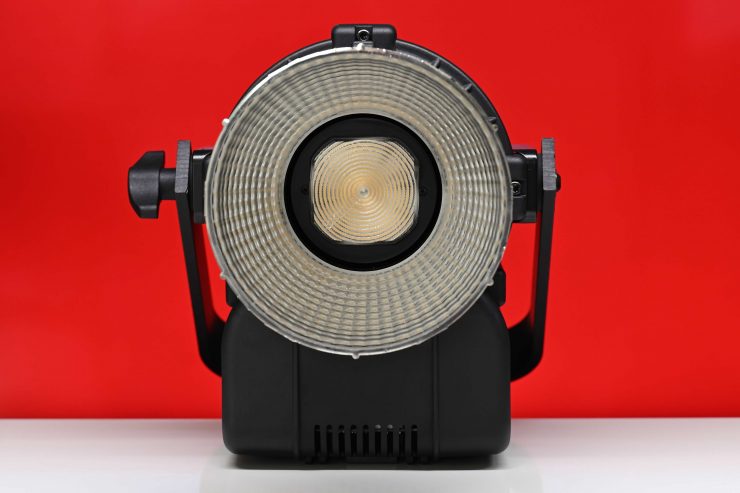
The light does feature an in-built Bluetooth module and this will allow it to be controlled via an app that is still in Beta. I didn’t have access to the Beta version of the app so I wasn’t able to test out how the Bluetooth control works.
Output & Color Temperature Accuracy
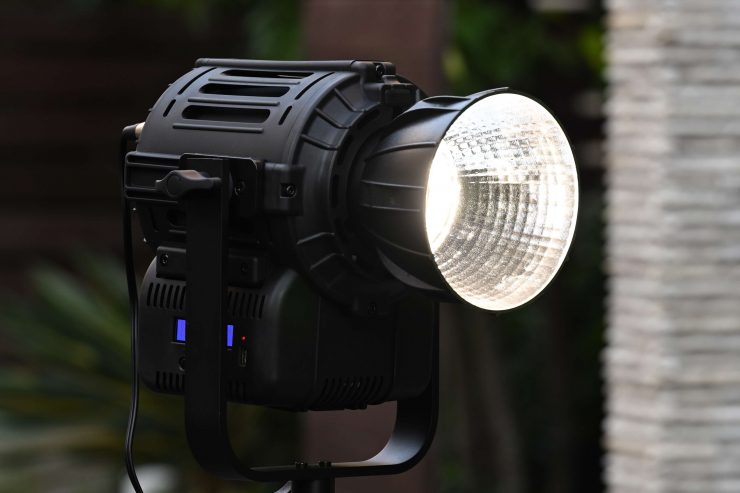
A big factor for a lot of people when buying a light is how much output it can produce. I tested the lights output at a variety of Kelvin color temperatures using a Sekonic C-800 at a distance of 1m (3.28ft) in a controlled environment
All measurements were taken from the edge of the fixture with the Sekonic C-800 at the exact same height and offset to where the middle of the light source was.
What you clearly need to know is that you can’t judge a light, nor should you make an assumption based on one set of tests. You need to look at all the data and not just cherry-pick something to get a full conclusion.
Below you can see the results:
5600K
Reflector (55 degrees)
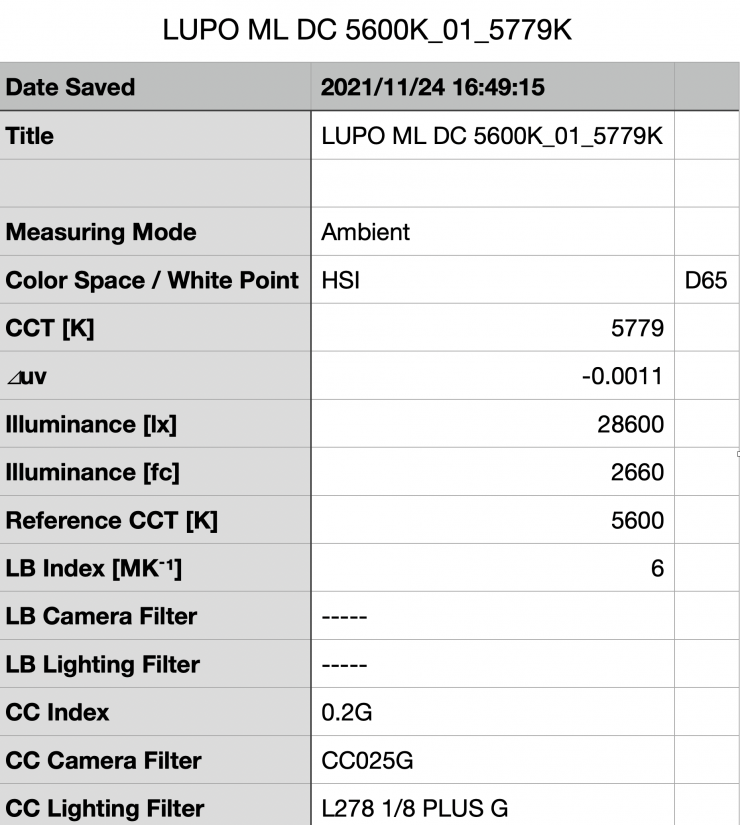
Above you can see the Lupo Movielight 300 Dual Color PRO when used at 5600K with its reflector recorded an output of 28600 lx / 2660 (fc). This is a decent amount of output from a fixture that draws 260W.
If you want an output comparison, the Aputure 300x when used with its hyper reflector at 5600K puts out 17500lx @1m. The Aputure 300x’s hyper reflector is also 55 degrees. Please bear in mind that the Aputure draws 350W as opposed to the 260W of the Lupo.
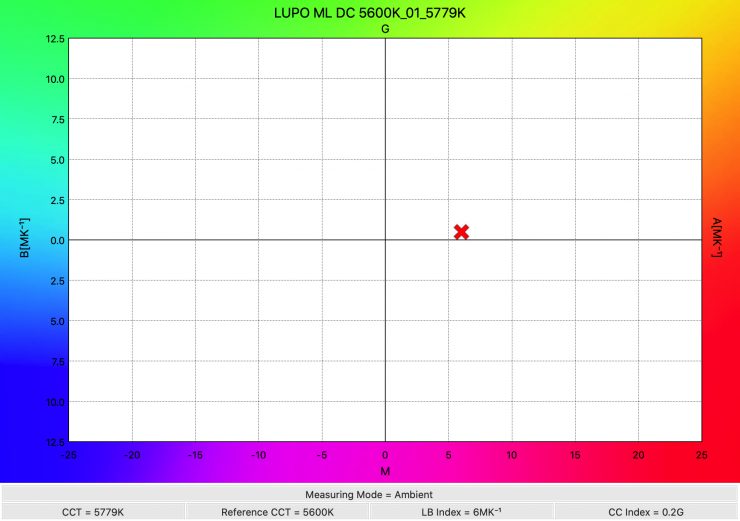
It recorded a Kelvin color temperature of 5779K, which was a reasonable reading, but it could have been better.
Powering it via a battery
I also tested the light when running it via a 260Wh V-lock battery and the output was the same as running it via mains power.
What I also like is that Lupo has made the Movielight so you can run it via lower-capacity batteries. I tried using a 150Wh battery and it powered up and worked perfectly. Now, you obviously won’t get the same output as using a higher capacity battery, however, I still managed to get 19200lx with the reflector when running the light via a 150Wh battery.
This is great to know because it means you can run the light remotely with a flight safe battery. This is something you can’t do with a lot of other similar lights.
5600K (No Reflector) 85 degrees
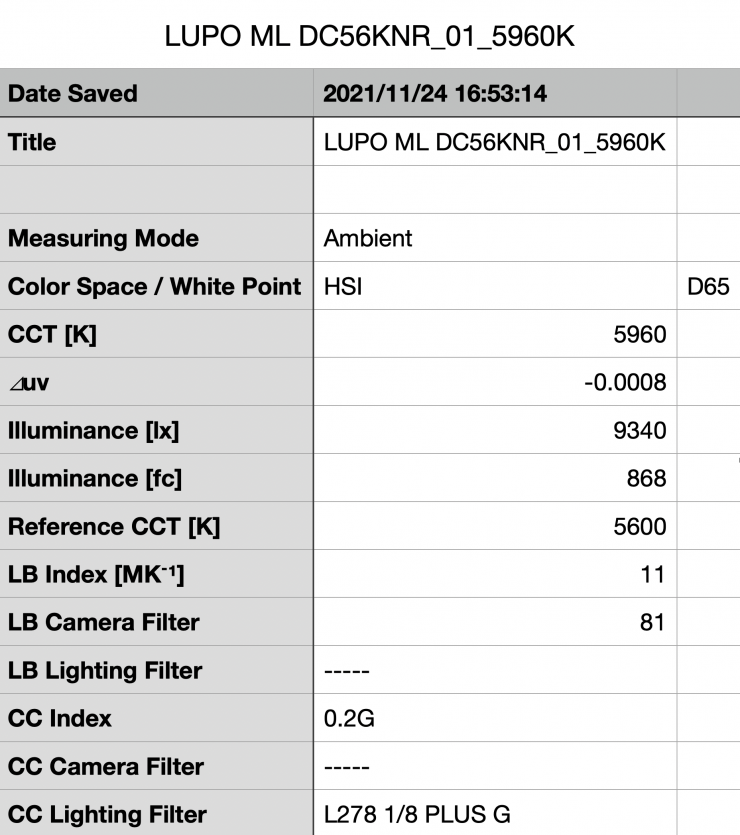
Above you can see the Lupo Movielight 300 Dual Color PRO when used at 5600K without its reflector recorded an output of 9340 lx / 868 (fc). This was 67.3% less output than it produced when using the reflector. Lupo states that the light should have 12,500lx at a distance of 1m when used open face. My reading was considerably less than that figure, however, Lupo may have been measuring 1m from the actual COB and not the edge of the fixture.
If you want an output comparison, the Aputure 300x when used open face at 5600K puts out 6300lx @1m. Please remember that the Aputure 300x has a wider beam angle of 105 degrees when used open face, however, it also draws 350W.
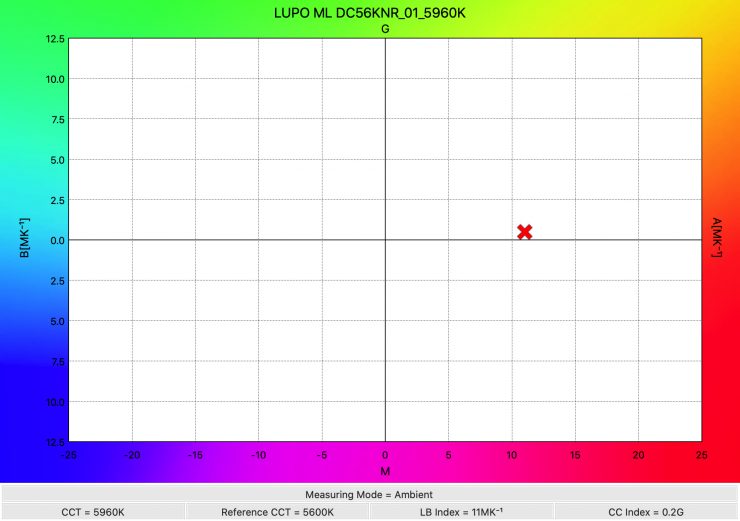
It recorded a Kelvin color temperature of 5960K, which was a little higher than what it recorded when using the reflector. This tells me that the reflector is actually altering the Kelvin color temperature but in a good way.
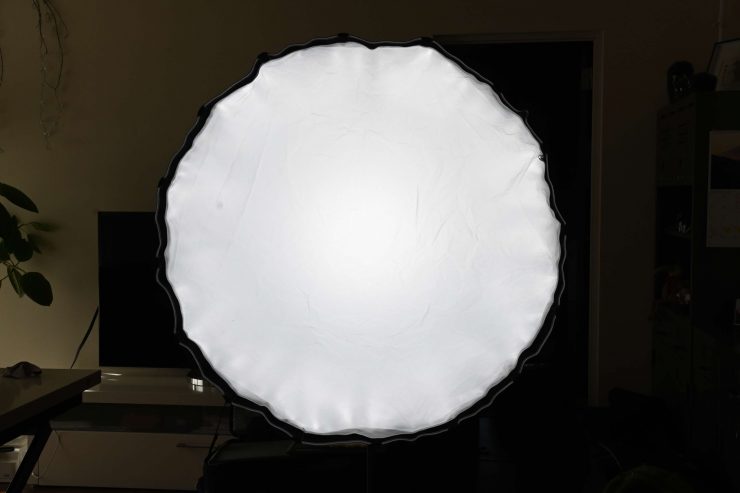
If I used the Movielight 300 Dual Color PRO with a generic parabolic softbox and an additional baffle I got 1540lx at a distance of 1m from the edge of the softbox.
When I tested the light with Lupo’s own Dome Pro which also has an included baffle I got a reading of 2290lx @1m.
3200K
Reflector (55 degrees)
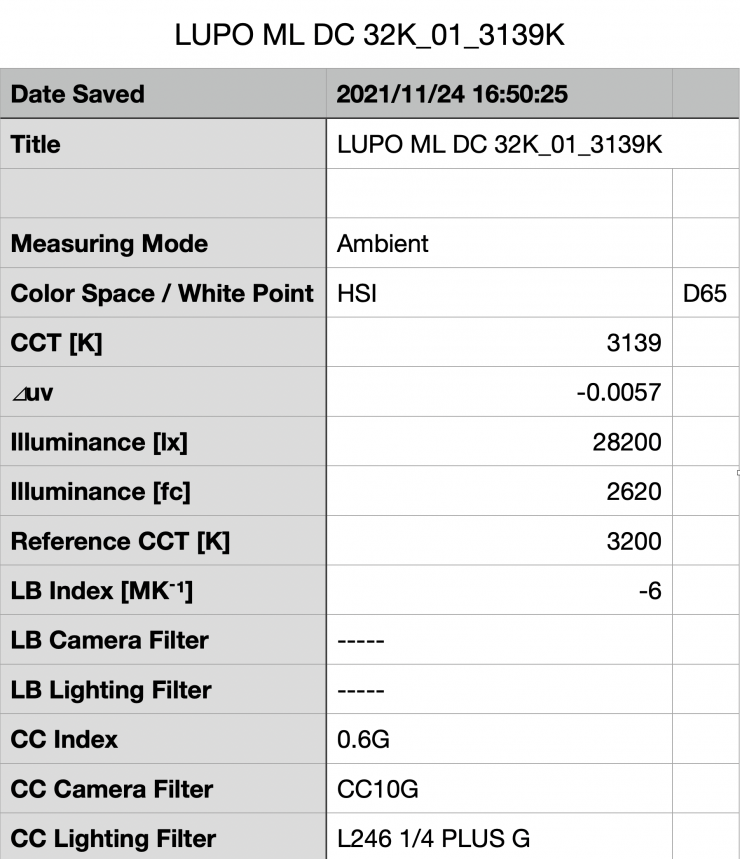
When used with its reflector at 3200K it had an output of 28200 lx (2620 fc). This was just 1.3% less output compared to when the light is used at 5600K with the reflector.
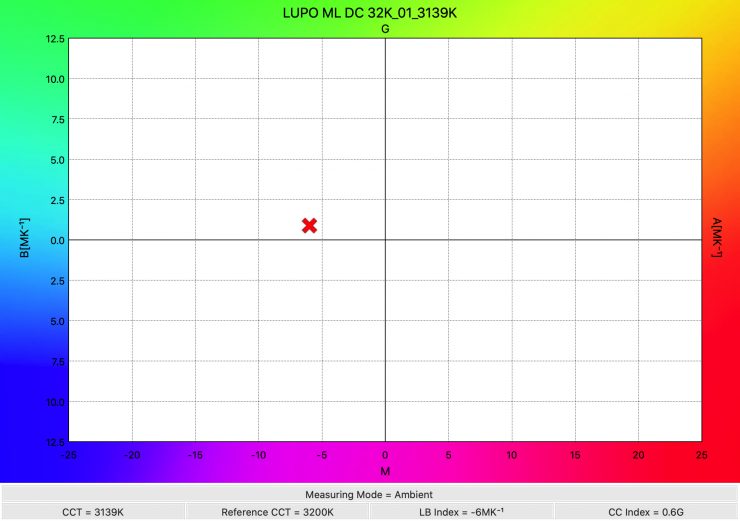
It recorded a Kelvin color temperature of 3139K. This result was pretty good.
How does it perform at various Kelvin color temperatures?
Summary of results
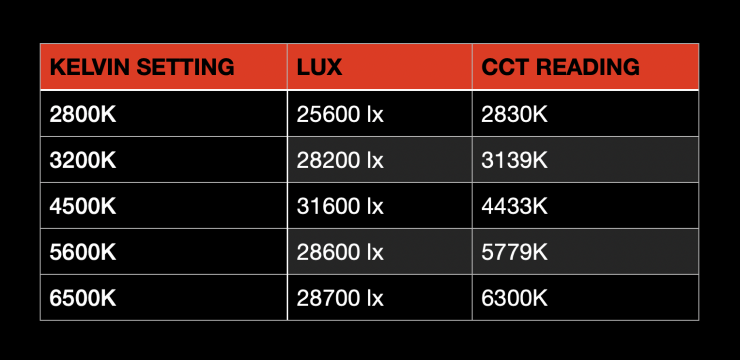
These results show me that the light’s output is fairly consistent across its Kelvin color temperature range. The light had the most output when it was used at 4500K. The output varies by 19% from the highest to the lowest figures I recorded.
The results also show me that the light could be better when it comes to Kelvin color temperature reproduction, especially once you get over 5600K, however, it is pretty accurate at 4500K and below.
Does the light’s Kelvin color consistency change once it is dimmed down?
With a lot of LED lights, the Kelvin color temperature can change significantly once you start dimming the fixture down. So how does the Movielight 300 Dual Color PRO fair? Below you can see the performance of the light when used at 5600K.
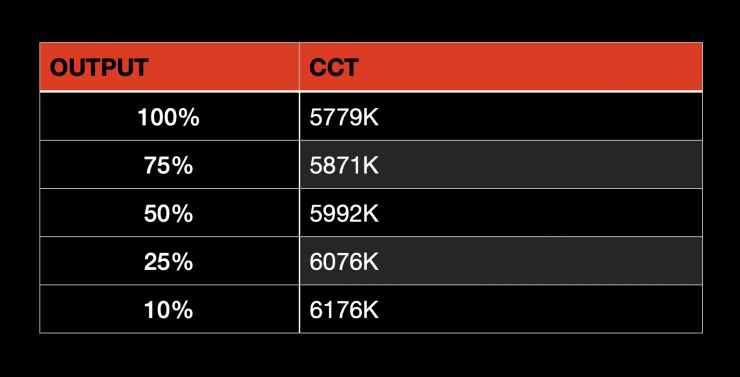
As you can see the light’s Kelvin color temperature does alter when the light is dimmed down. This is something you need to be aware of and it seems to be the Achillies Heel of Lupo lights. In saying that, it isn’t like the Kelvin color temperature is changing by 1000K.
How linear is the output?
I wanted to see how linear the light’s output was when used at 5600K with the dimming set to LINEAR. Below you can see the results.
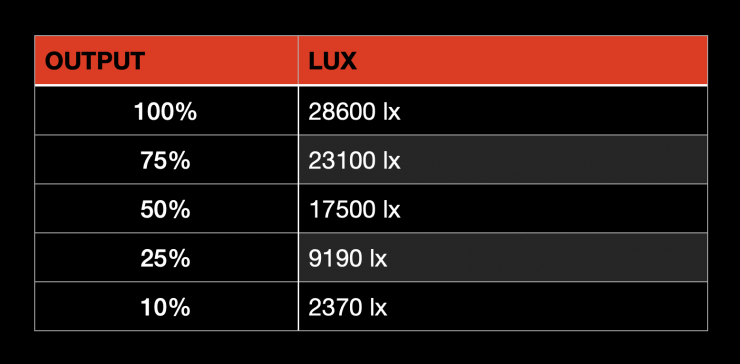
The results show me that the light’s output is reasonably linear once you start dimming the fixture down. At 50% output, it had 38.8% less output than when it was used at 100% output. At 25% the fixture had 67.8% less output than when it was used at 100%. This shows me that the light’s output is not completely linear.
You can adjust the dimming curve between LINEAR, LOGARITHMIC, or EXPONENTIAL.
CC Index & ⊿uv
The CC Index displays the CC correction value and whether any magenta or green need to be added or subtracted. 1 CC corresponds to 035 Kodak CC values or 1/8 Rosco filter values. Any reading less than +1.00 or -1.00 and you’re probably not going to need to make any kind of adjustment. The ⊿uv is the value to show how much this light is away from being an ideal light source (black body radiation = incandescent lamp). As with the CC Index you want this number to theoretically be zero. Kelvin is not a linear value, so we need to convert from Kelvin to MK-1 to compare the values of color temperature. To calculate from Kelvin to Mired is MK-1= 1*1000000/Kelvin. While this may sound confusing, it is the only way of measuring if the Kelvin shift is significant enough to warrant having to use a filter for correction. Below are the results for the light when it was used with its reflector at 5600K.
Kelvin Vs MK-1
| Kelvin | Difference in K | MK-1 | Difference in MK-1 | |
| SET VALUE | 2800K | 0 | 357.14 | 0 |
| ACTUAL READING | 2830K | 30 | 353.35 | 3.79 MK-1 |
| SET VALUE | 3200K | 0 | 312.50 | 0 |
| ACTUAL READING | 3139K | 61 | 318.57 | -6.07 MK-1 |
| SET VALUE | 4500K | 0 | 222.22 | 0 |
| ACTUAL READING | 4433K | 67 | 225.08 | -2.86 MK-1 |
| SET VALUE | 5600K | 0 | 178.57 | 0 |
| ACTUAL READING | 5779K | 179 | 173.04 | 5.53 MK-1 |
| SET VALUE | 6500K | 0 | 153.84 | 0 |
| ACTUAL READING | 6300K | 200 | 158.73 | -4.89 MK-1 |
These figures might look confusing, but what it tells me is that the light is reasonably accurate across its Kelvin color temperature range. Any MK-1 score that is under -9/9 means you wouldn’t have to use any color correction gels. Again, we don’t want to judge a light based on one set of scores. Scores that are under -6/+6 are considered to be good.
CC INDEX & ⊿uv
| CC INDEX | ⊿uv | |
| 2800K | 0.4G | -0.0033 |
| 3200K | 0.6G | -0.0057 |
| 4500K | 0.5G | -0.0059 |
| 5600K | 0.2G | -0.0011 |
| 6500K | 0.2G | -0.0000 |
These results show me that the light skews a little bit towards magenta, but as we will find out later on in the review this isn’t actually anything to be concerned about. It was interesting to see that at 6500K it recorded a perfect ⊿uv score. This is very rare.
Color Rendering
5600K Reflector
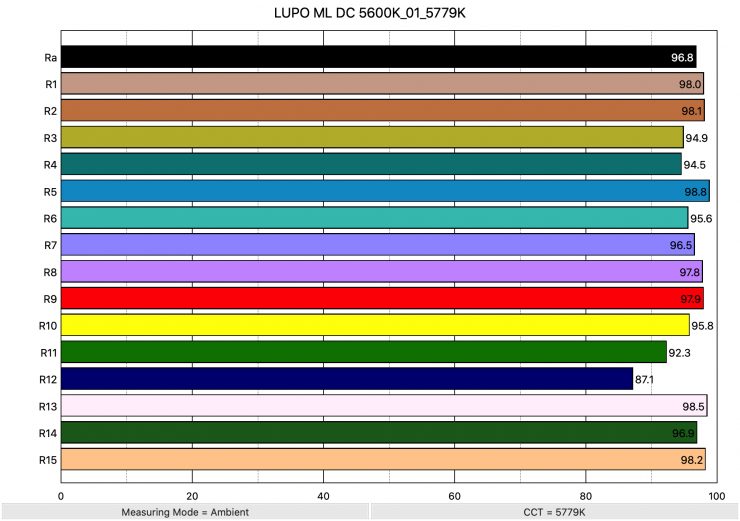
So now that we have seen how much output the Movielight 300 Dual Color PRO produces, how does it perform when it comes to replicating accurate colors? Above you can see that the light recorded an average CRI (R1-R8) of 96.8 and an extended CRI (R1-R15) of 96.06. For replicating accurate skin tones it recorded 97.9 R9 (red), 98.5 for R13 (closest to caucasian skin tones), and 98.2 for R15 (closest to Asian skin tones). These are excellent results. Only R12 was below 90.
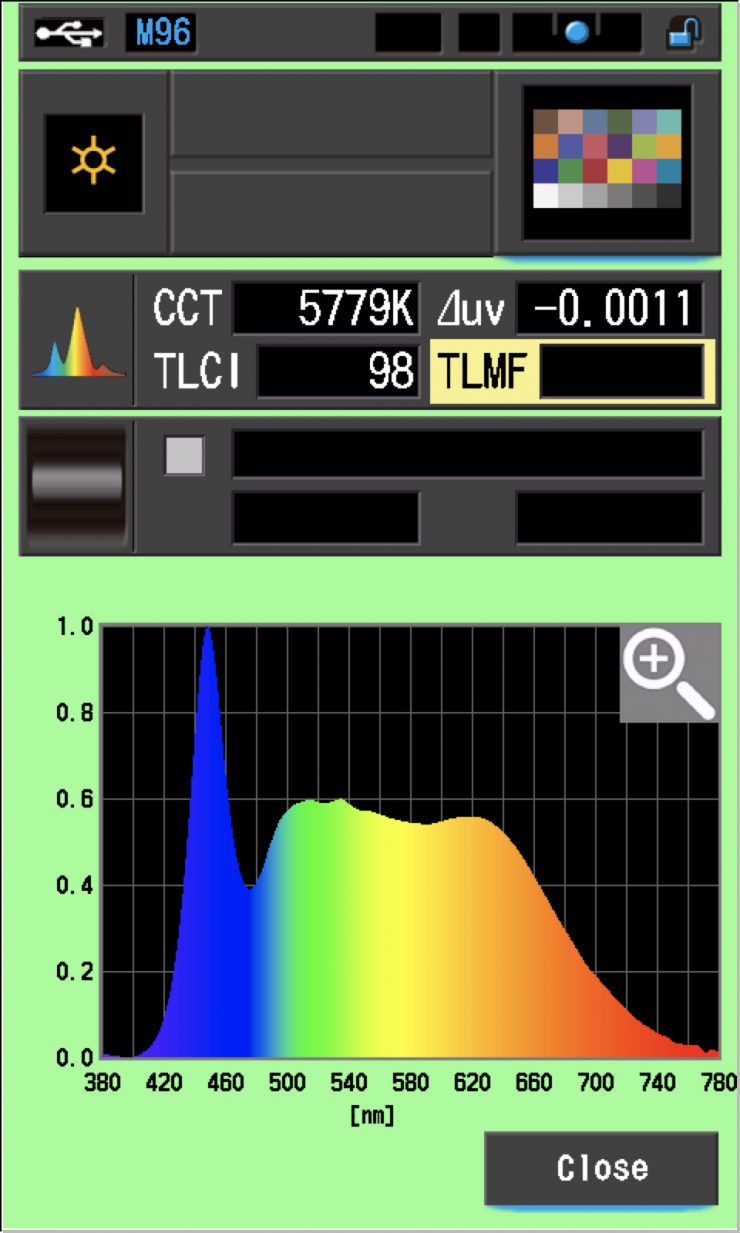
The light when used at 5600K recorded a TLCI score of 98.
3200K Reflector
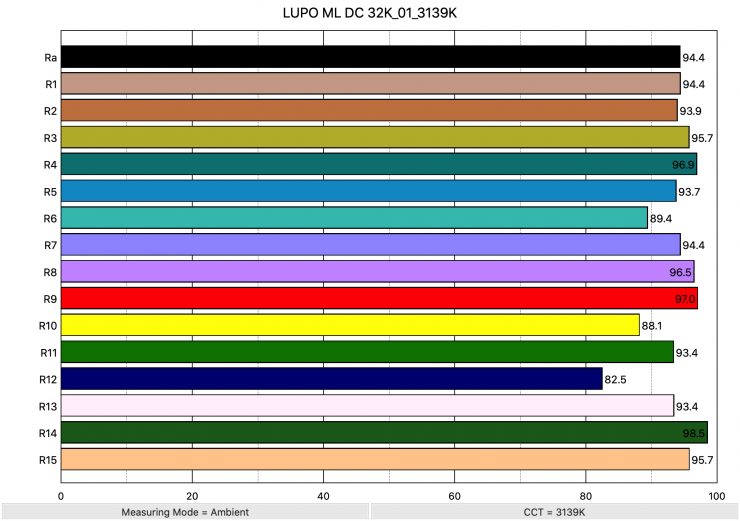
Above you can see that when the light was set at 3200K it recorded an average CRI (R1-R8) of 94.4 and an extended CRI (R1-R15) of 93.56. For replicating accurate skin tones it recorded 97.0 R9 (red), 93.4 for R13 (closest to caucasian skin tones), and 95.7 for R15 (closest to Asian skin tones). These are pretty good results, but not as good as when the light is used at 5600K.

The light when used at 3200K recorded a TLCI score of 98.
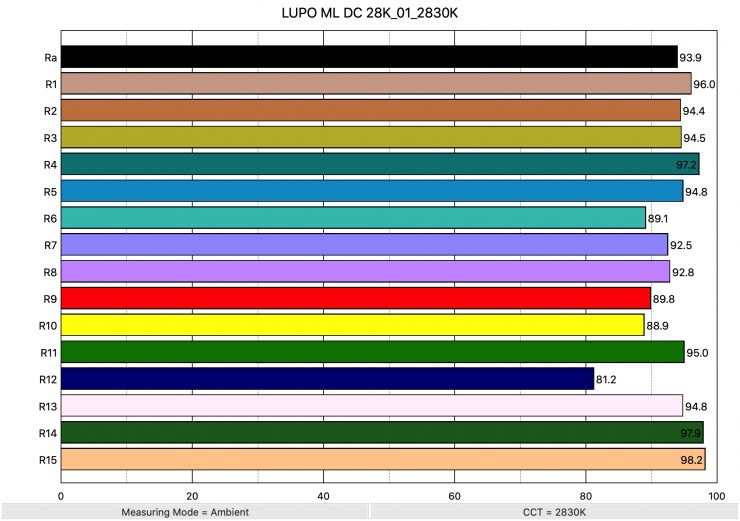
2800K 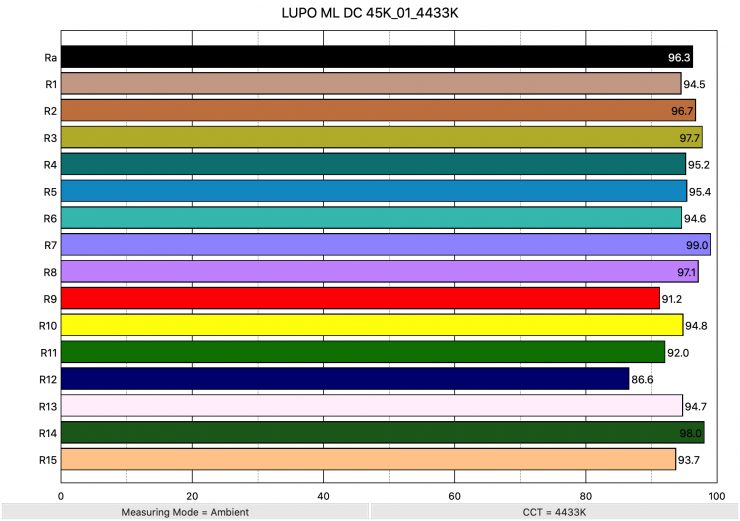
4500K 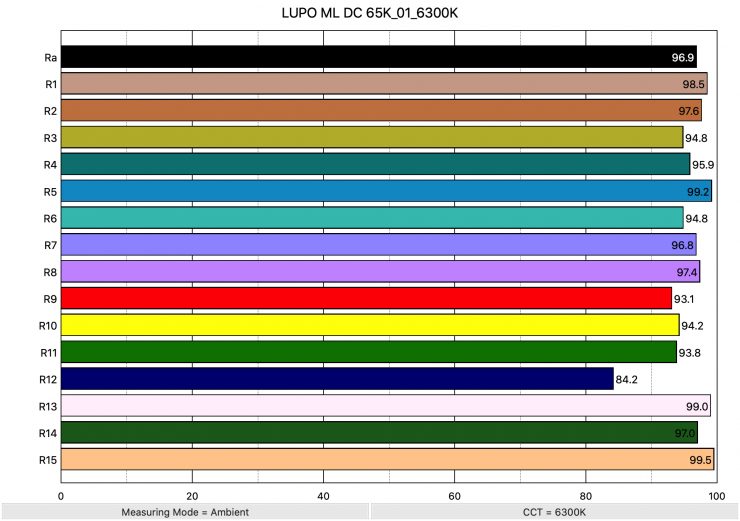
6500K
Above you can see the color rendering scores when the light was used at 2800K, 4500K, and 6500K.
TM-30
TM-30 is a relatively new color rendering standard that was developed to deal with the limitations of CRI. TM-30 looks at 99 individual colors. These 99 colors are categorized into seven groups: nature, skin color, textiles, paints, plastics, printed material, and color systems.
TM-30 scores go from 0 – 100. The higher the score, the more accurate a light is at producing colors. Any TM-30 Rf score in the ’90s is considered to be good. What is interesting and something that you need to be very aware of is that two separate light sources with the exact same CRI scores can render colors very differently. A light with a high CRI rating could have a low TM-30 score. Conversely, a light with a good TM-30 score could have a bad CRI score.
Now, there are two measurements associated with TM-30, Rf and Rg.
- Rf (Color Fidelity)
- Rg (Color Gamut)
With Rf value, ideally, you want a score in the 90’s.
With Rg value, a score below 100 indicates that the light source renders colors with less saturation than the reference source. So ideally you want this score to be above 100.
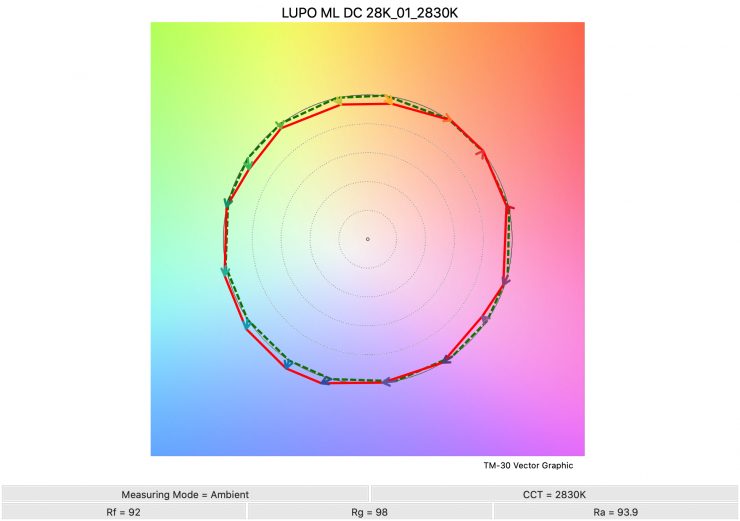
2800K 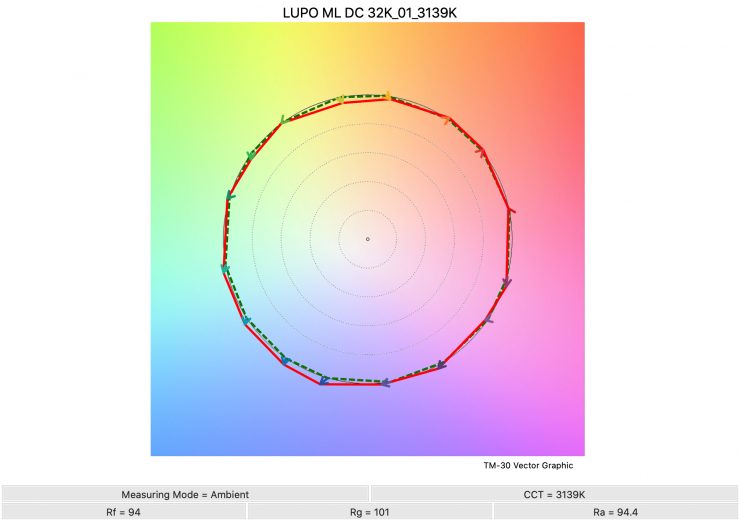
3200K 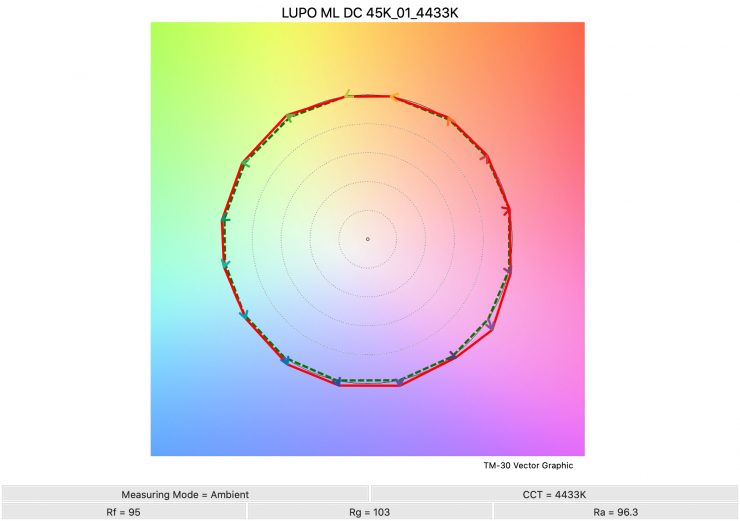
4500K 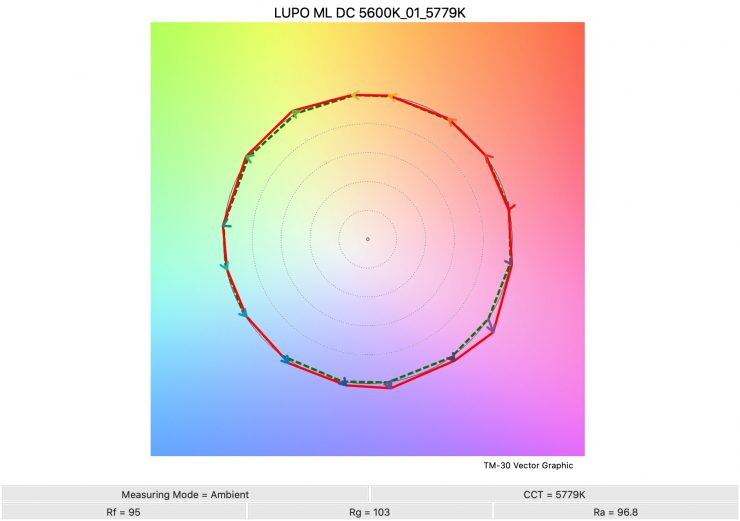
5600K 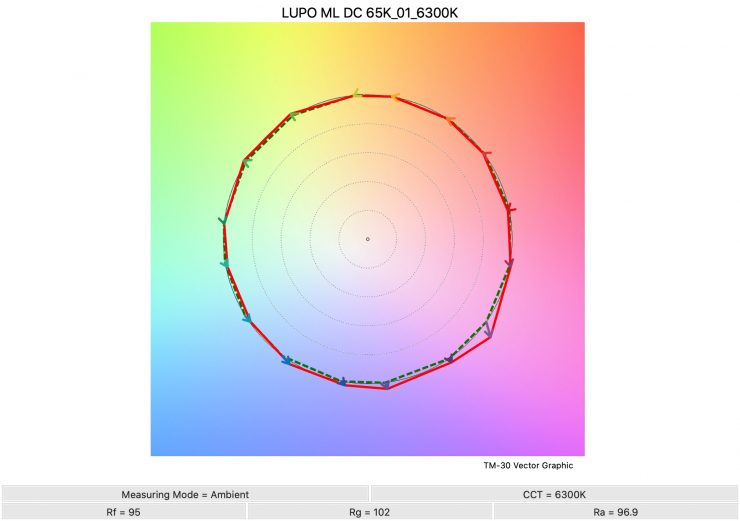
6500K
Above you can see the scores for the Lupo Movielight 300 Dual Color PRO at various Kelvin color temperatures. Below I have listed the figures as well.
| Rf | Rg | |
| 2800K | 92 | 98 |
| 3200K | 94 | 101 |
| 4500K | 95 | 103 |
| 5600K | 95 | 103 |
| 6500K | 95 | 102 |
The TM-30 scores are all good and it shows me that the light is pretty consistent at replicating accurate colors.
SSI
SSI (Spectral Similarity Index) was developed by the Sci-Tech Council of the Academy. SSI gives me the ability to set any light as a standard, or use predefined standards (such as CIE D55), and then give other lights an SSI score based upon how well they will match standards such as CIE D55 measure spectral response and compare it directly against an ideal light source.
SSI is a much better way to judge an LED light than CRI or TLCI.
SSI is useful to see how well different lights will play together. As the Sekonic C-800 Spectromaster can measure SSI, I decided to test out the Movielight 300 Dual Color PRO to see how it performed.
5600K Reflector
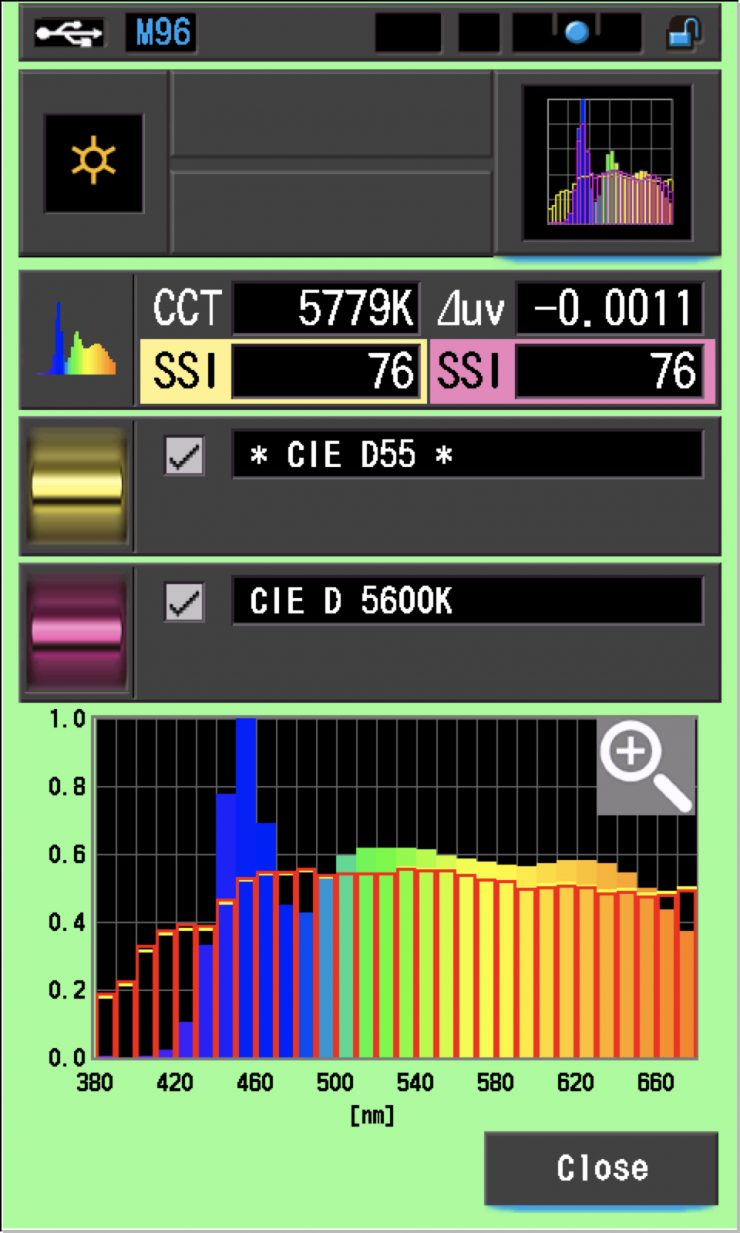
The scores show that the light does a good job of accurately replicating a CIE D55 source. A score in the low to mid-70s is very typical for a 5600K LED light.
3200K Reflector
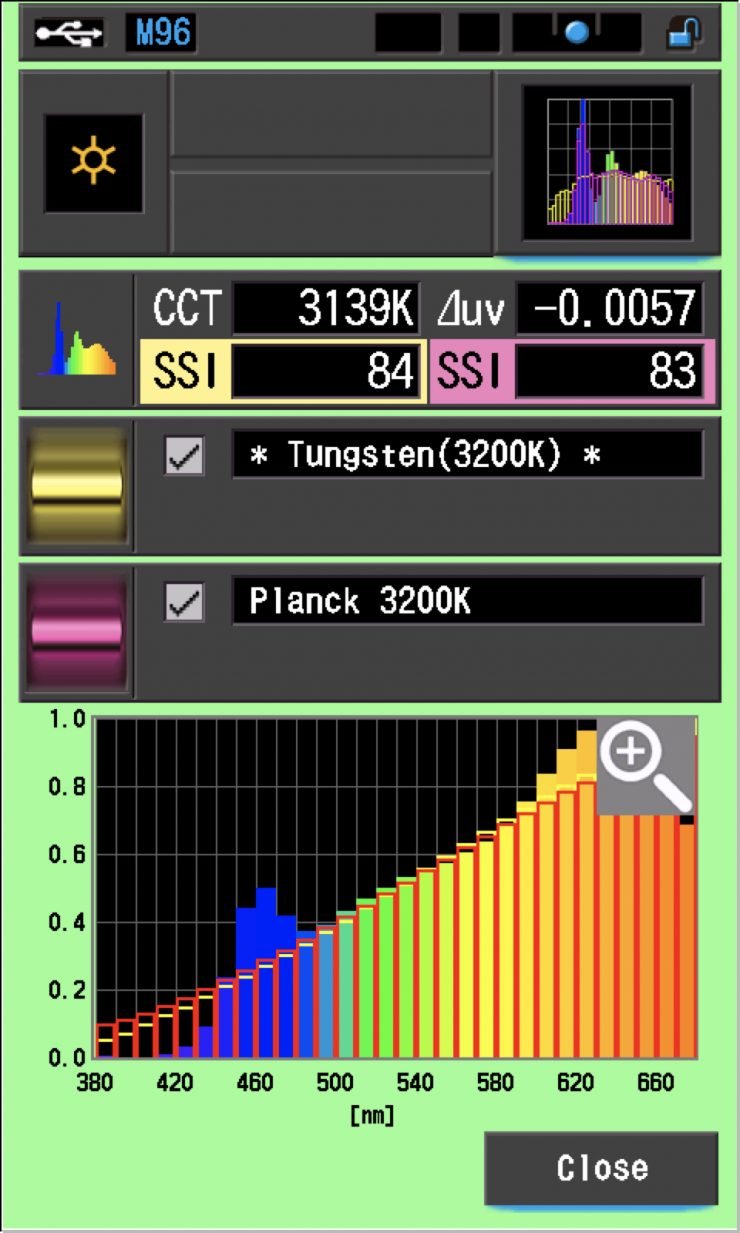
Above you can see that the light does a reasonably good job of accurately replicating a tungsten source. A score in the low to mid-80s is very typical for a light when used at 3200K.
The main reason we want to record SSI scores is so we can see how well they match with other lights. I was curious to see how well the Lupo Movielight 300 Dual Color PRO matched the ARRI Orbiter and the Nanlux Evoke 1200. Below you can see the results.
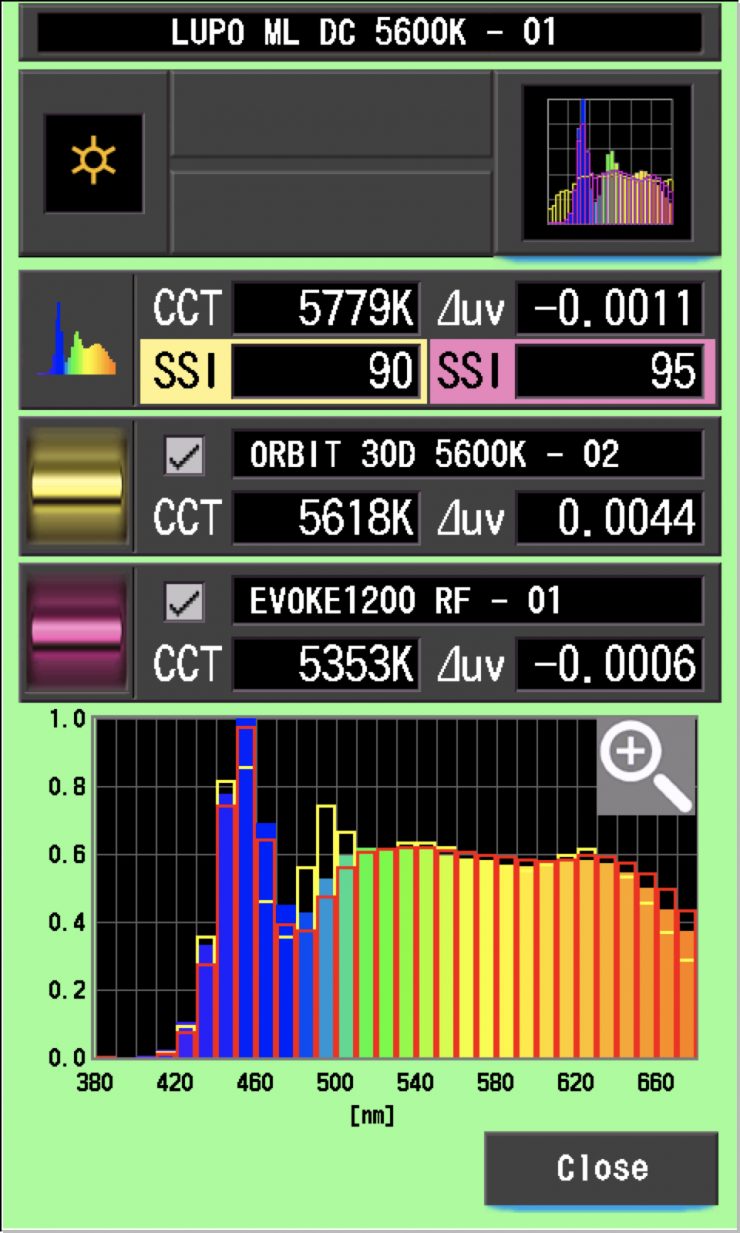
As you can see, the Movielight 300 Dual Color PRO and Nanlux Evoke 1200 are a pretty good match. Even the ARRI Orbiter matches reasonably well. A score in the high 80’s or low 90’s isn’t that bad and with a bit of tweaking, you could probably get the ARRI Orbiter to match the Lupo reasonably well.
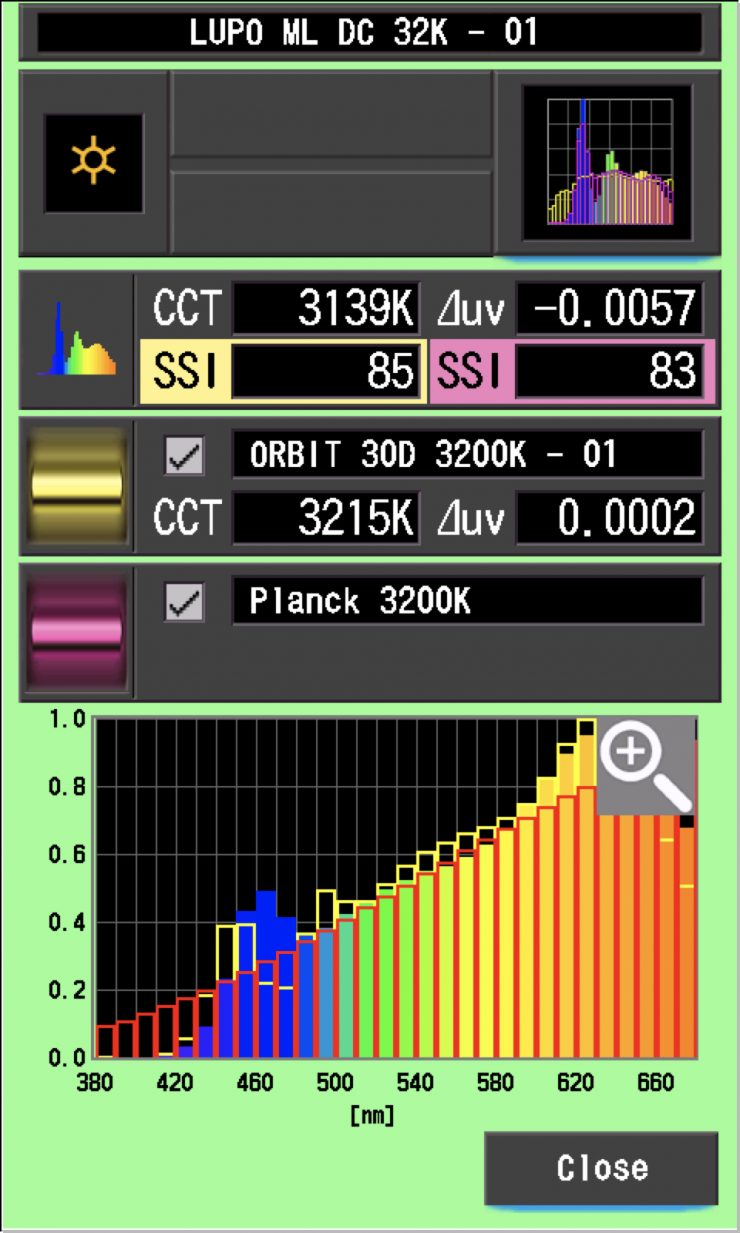
Above you can see how the Movielight 300 Dual Color PRO matches the ARRI Orbiter. The Movielight matches the ARRI Orbiter reasonably well. A score in the high 80’s or low 90’s isn’t that bad and with a bit of tweaking, you could probably get the ARRI Orbiter to match the Lupo reasonably well.
Being able to measure SSI in advance and compare different lights you may be using together is a great way of finding out what lights will work together and what adjustments need to be made.
Spectral Distribution
5600K
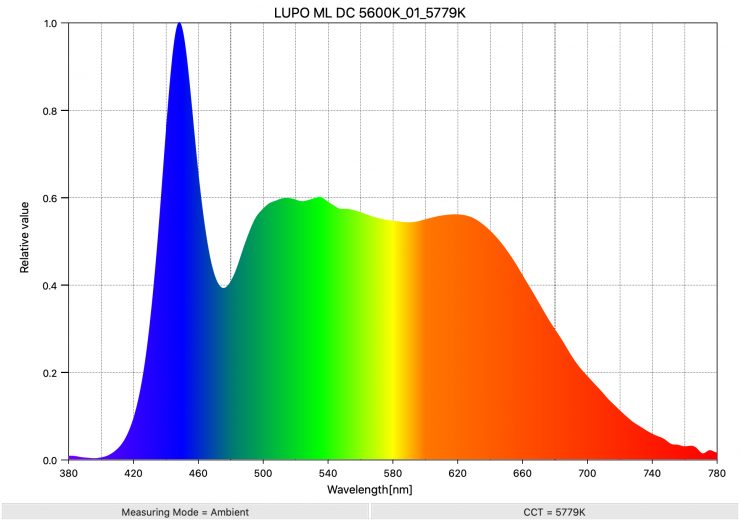
Above you can see the spectral distribution of the Lupo when used at 5600K. The spectral distribution is reasonably full, but then again this is not an RGBWW fixture.
3200K
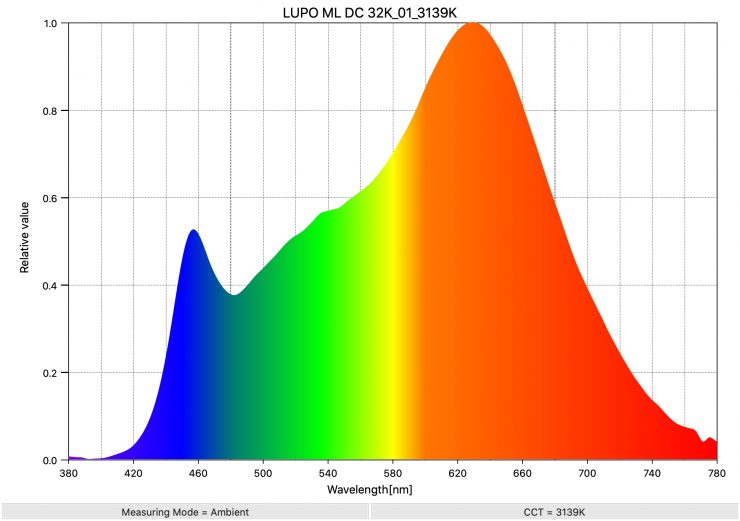
Above you can see the spectral distribution of the Lupo when used at 3200K. The spectral distribution is nice and linear, and there aren’t any spikes where there shouldn’t be.
Real-World Usability
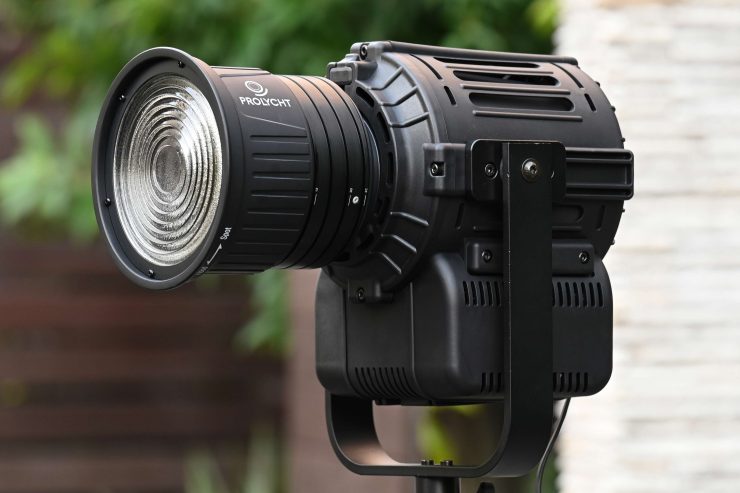
The Movielight 300 Dual Color PRO will create a decent amount of output, in a compact-sized fixture that can be powered remotely in the field.
It has enough output that it could be used to match brighter backgrounds if you need to shoot talent outdoors.
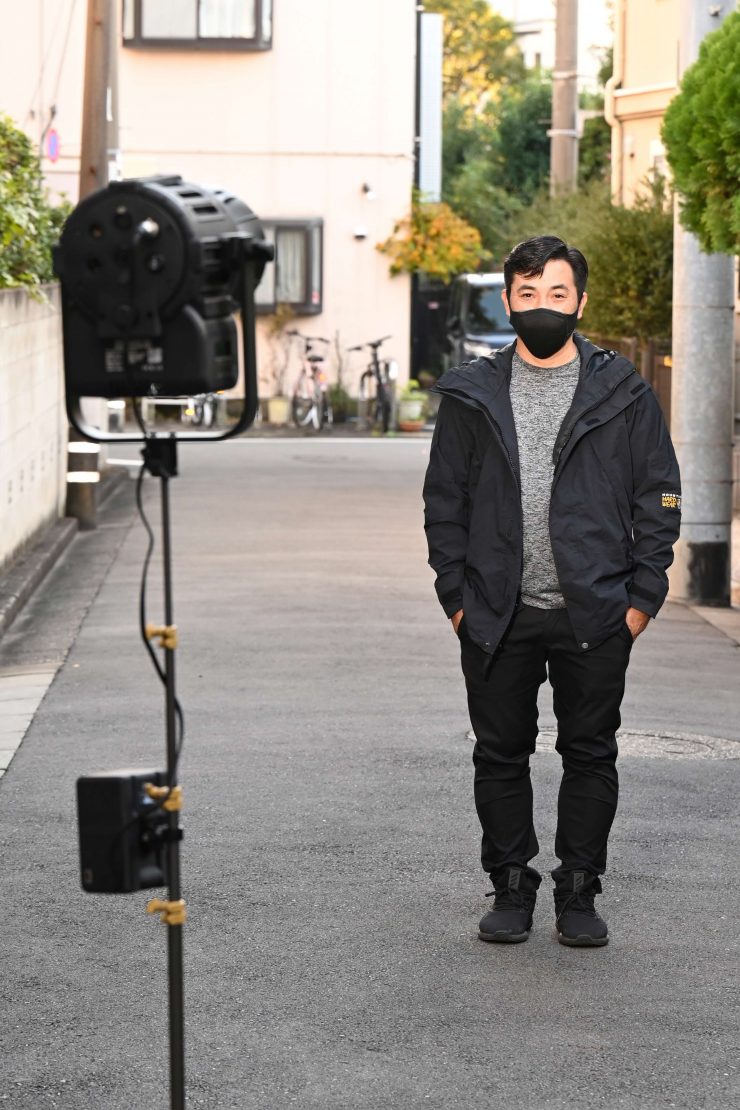
Light on 
Light off
Above you can see how much output the light has when using the reflector with a subject around 5m / 16.4′ from the fixture.
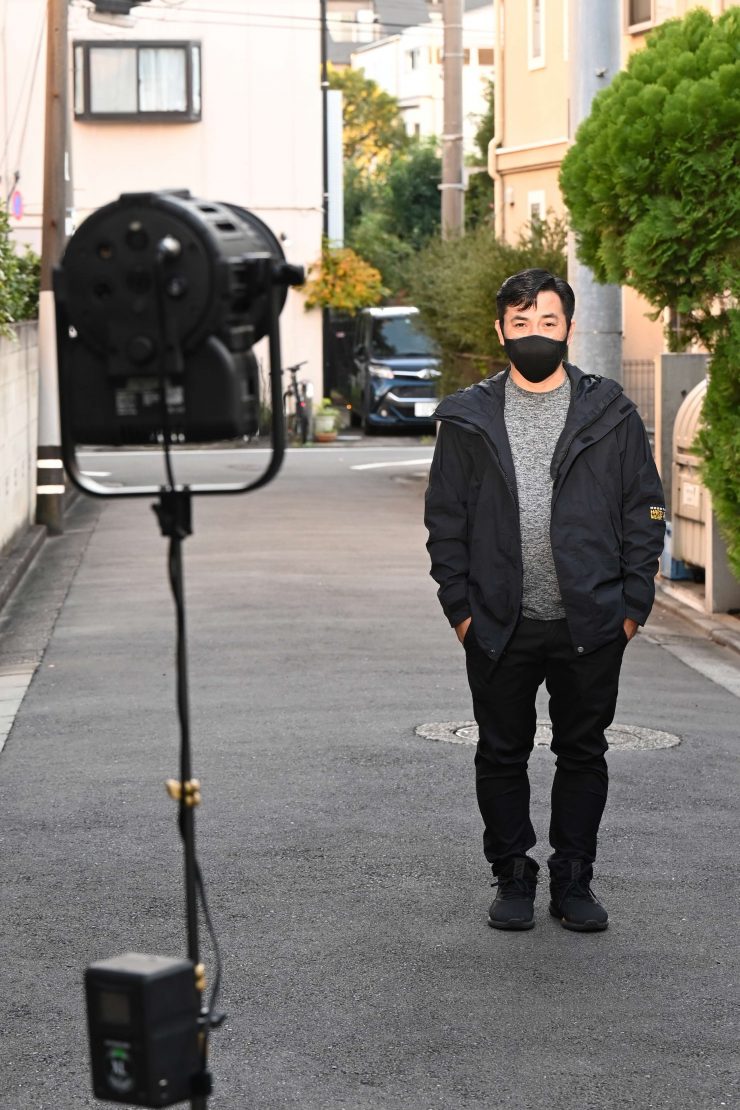
Light on 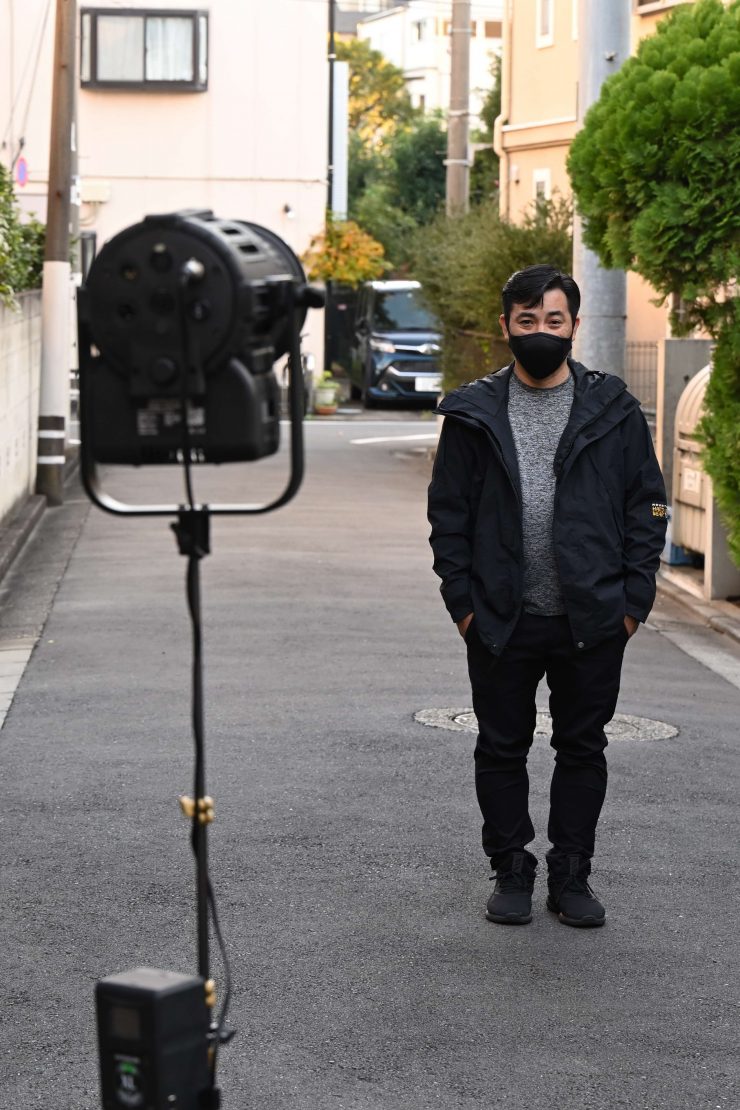
light off
Above you can see how much output the light has when using the Prolycht 2x Fresnel with a subject around 5m / 16.4′ from the fixture.
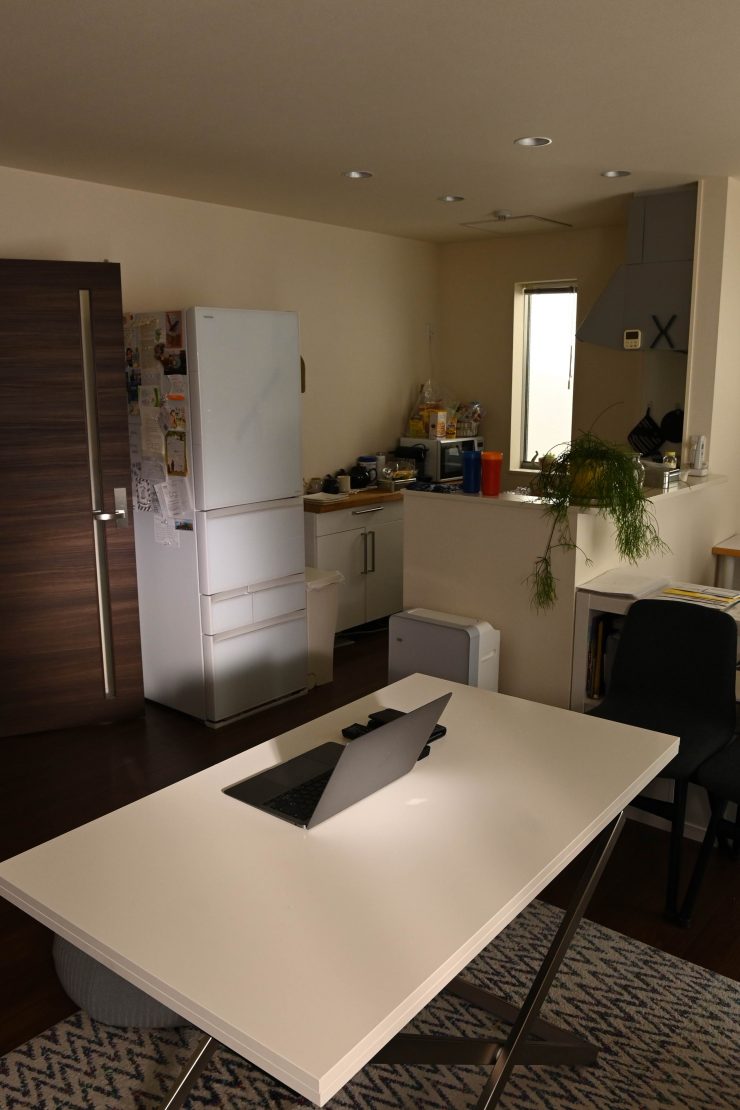
Full Spot (no barndoors) 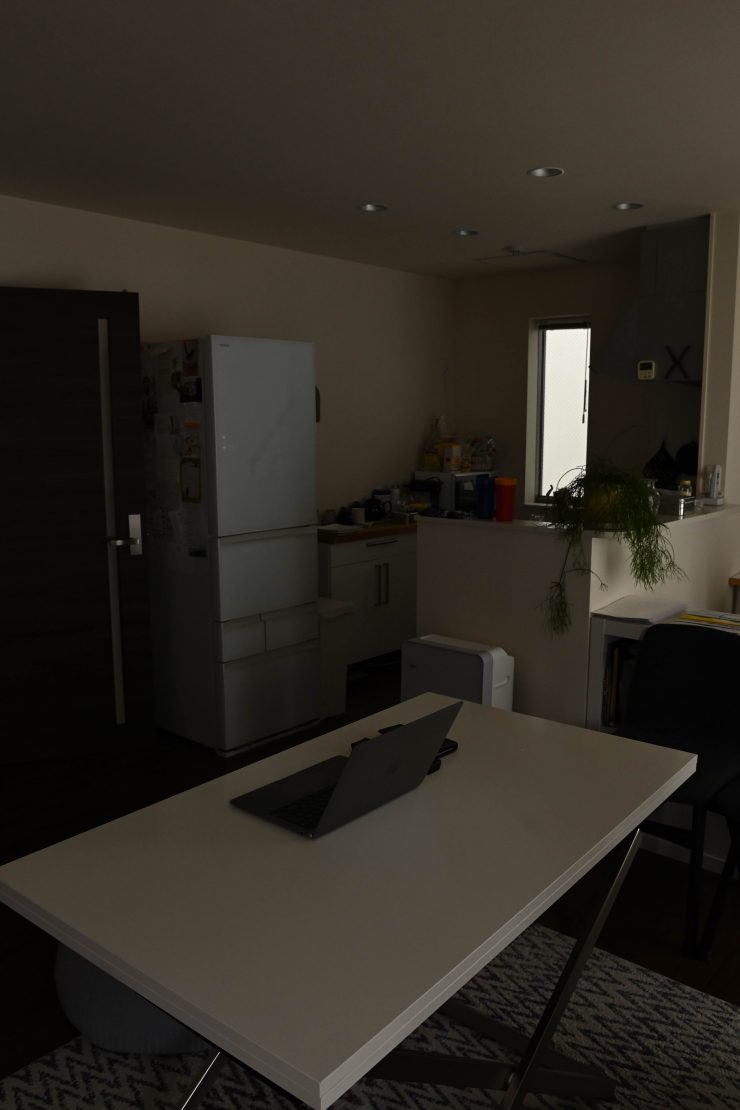
Light Off
Above you can see some quick examples of punching the light through a window and light curtain from outside to replicate sunlight coming in. I have taken pictures with the light on and with it off at the exact same camera settings.
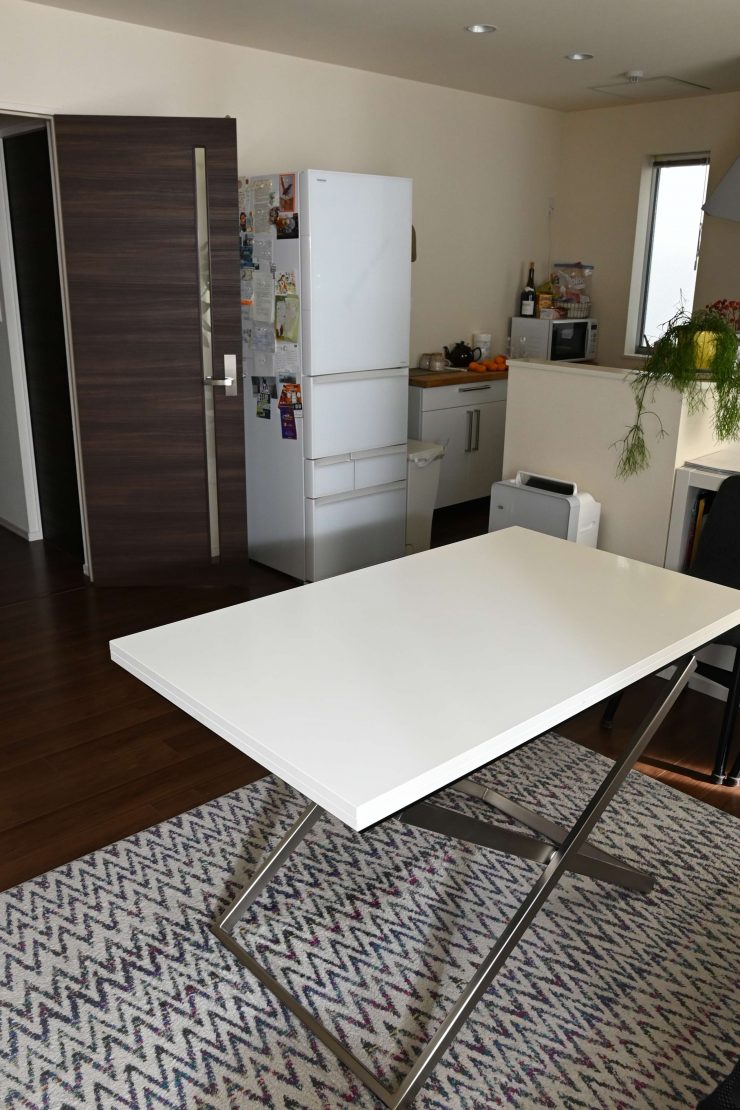
Light on 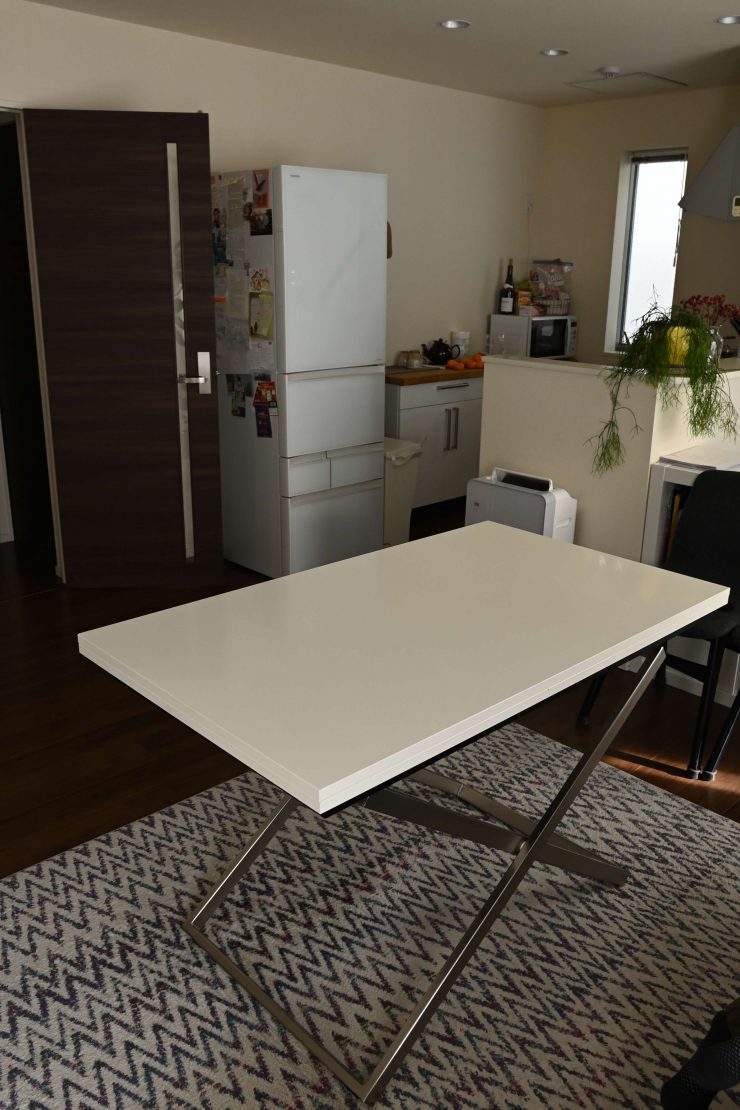
Light off
Above you can see what the light looks like being punched through a light curtain from outside. This is with the reflector being used.
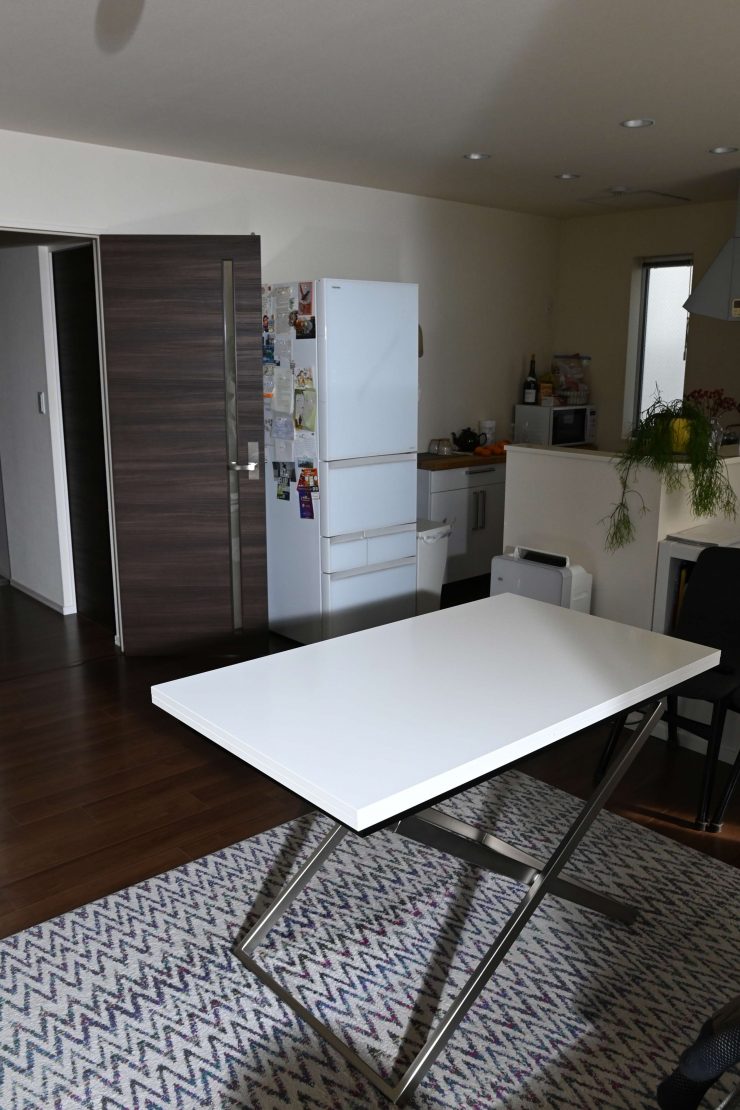
Light on 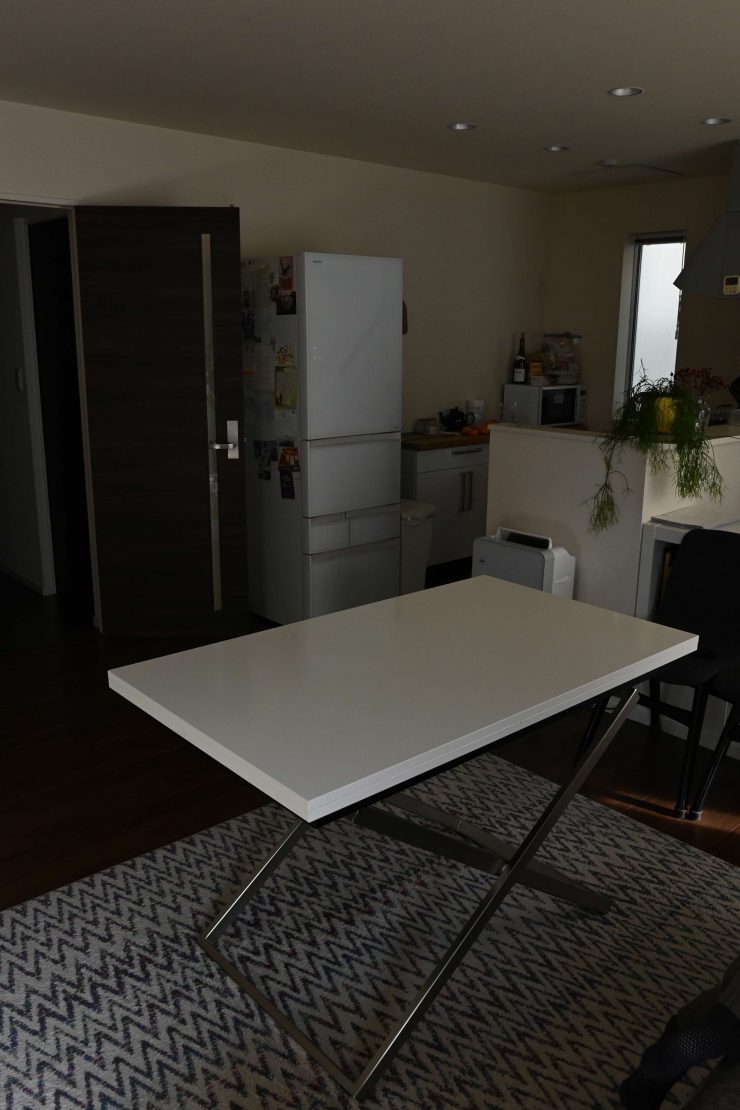
Light off
Above you can see what the light looks like when it is placed outside and blasted into the room. This is with the reflector being used.
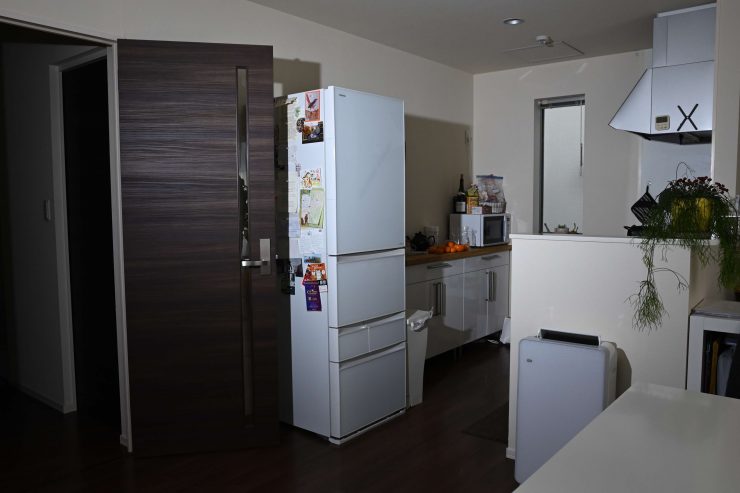
Light on 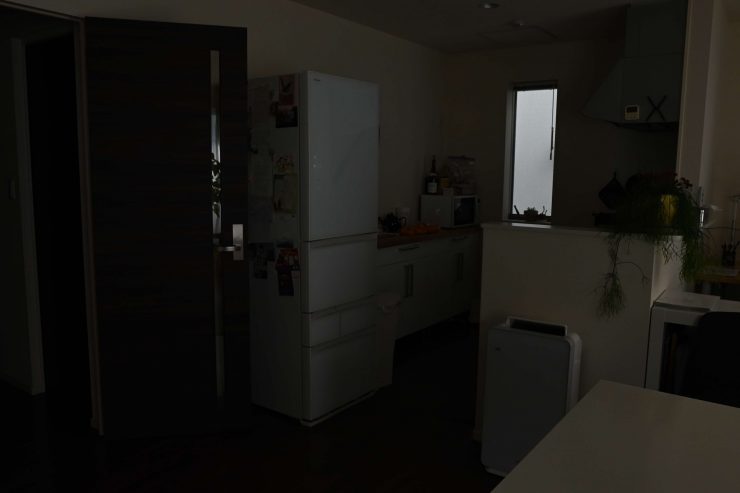
Light off
Above you can see what the light looks like when it is used open face.
Above you can see what the light looks like when used with the Prolychyt 2x Fresnel.
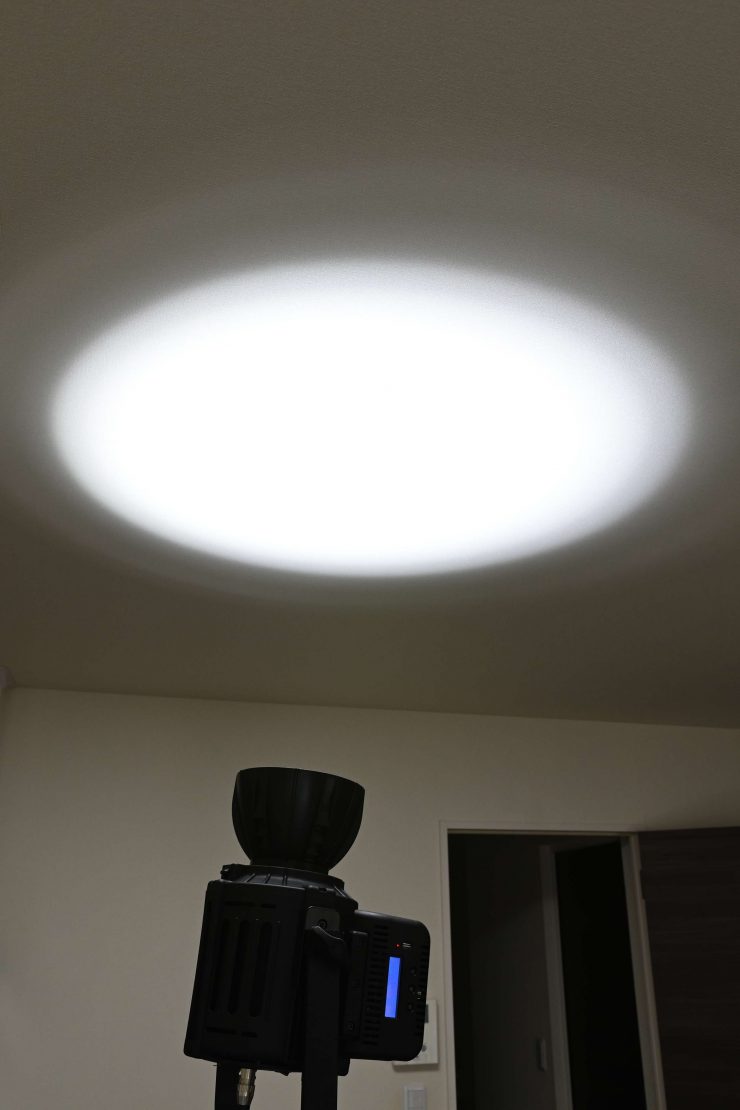
Reflector 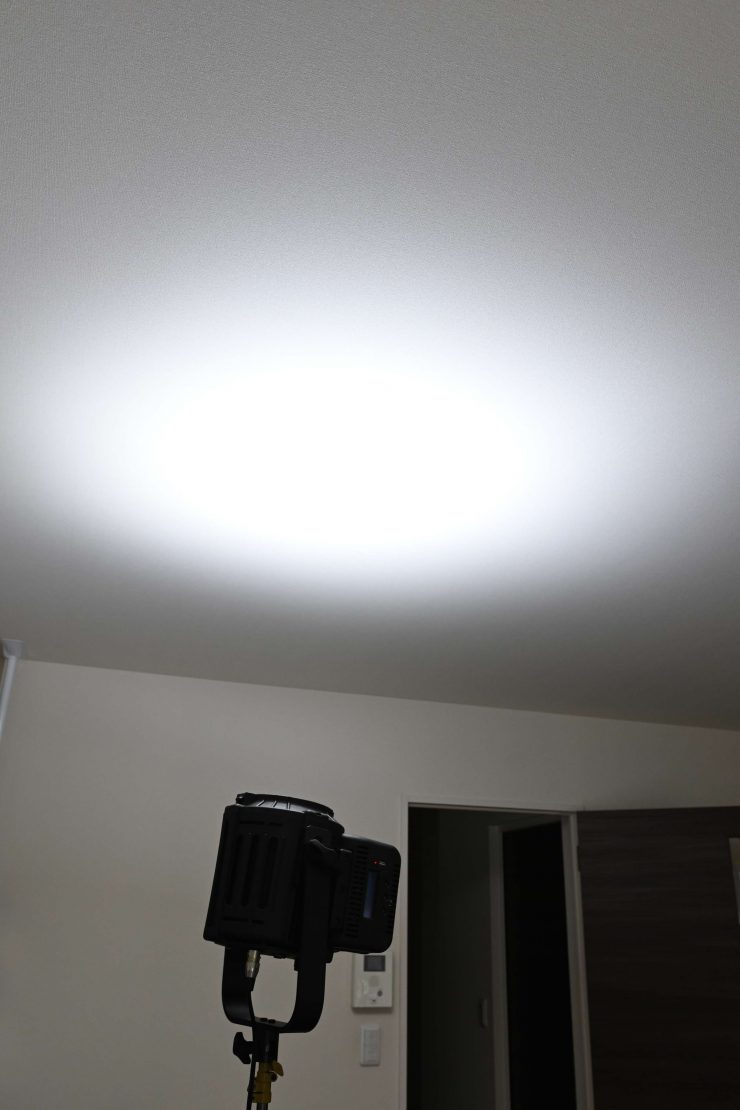
Open face 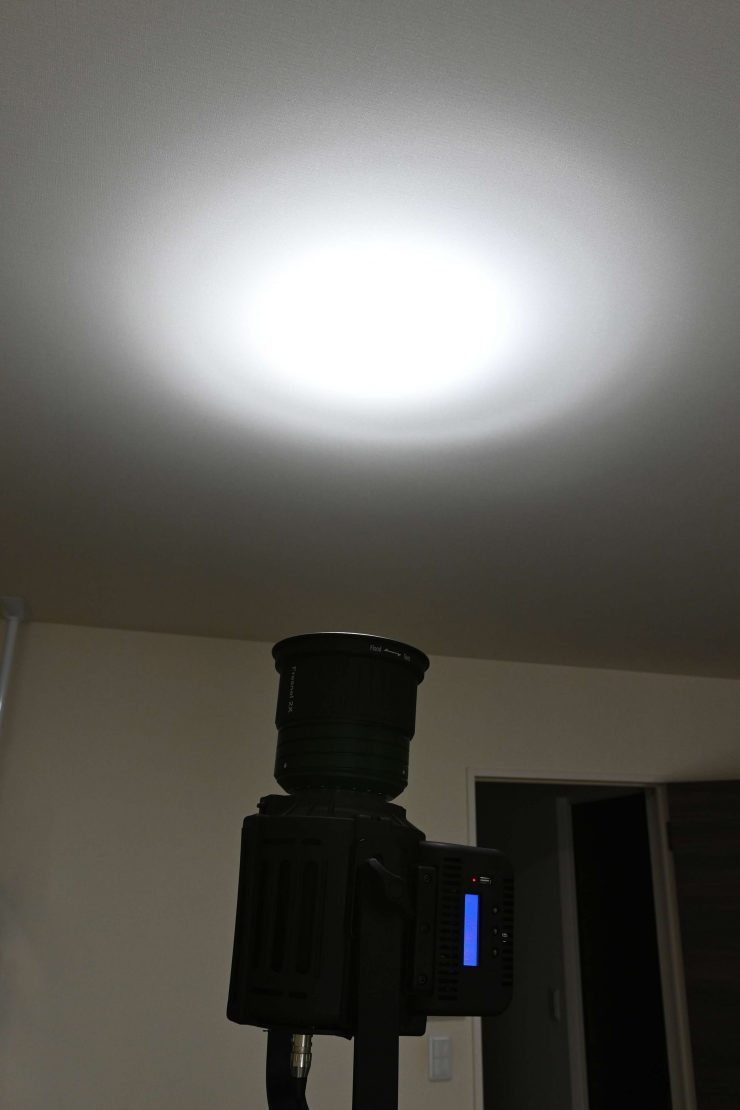
Prolycht 2x Fresnel
Above you can see what it looks like if it is punched directly into the ceiling using the reflector, open face, and with the Prolycht 2x Fresnel.
Above you can see what the light looks like when it is used with the Prolycht Orion 300 FS Projection Lens Kit. The Lupo works really well with this Projection Lens kit. You can create a tiny light source, or a large source using gobos.
As far as using a third-party softbox is concerned, the results will depend on what type of softbox you have.
If you already own a Bowens mount softbox, then there is probably no need to buy a new one to use with this light. However, I do highly recommend Lupo’s own Dome Pro parabolic softbox.
Price
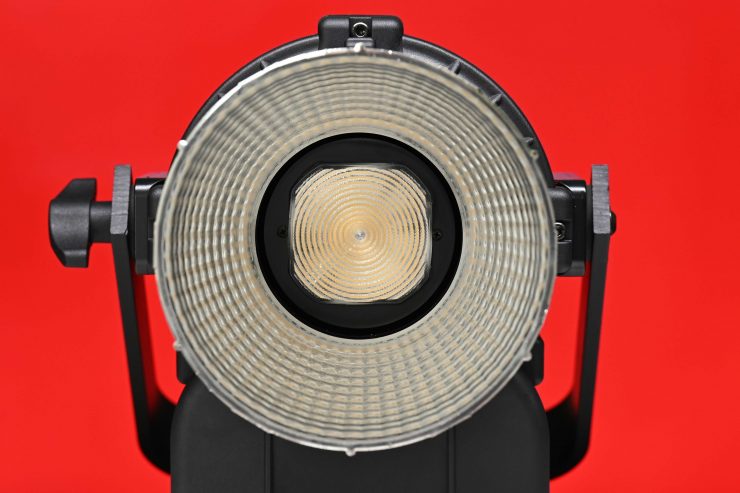
The Lupo Movielight 300 Dual Color PRO retails for $999 USD. It should be available and shipping soon.
There is also a Lupo Movielight 300 Dual Color PRO Kit that retails for $1,098 USD. This kit includes a case, V-lock clamp, and a D-tap to 4 pin XLR power cable.
Lupo’s Dome Pro parabolic softbox retails for $219 USD.
Competition
Below you can see some of the other competing lights.
| WEIGHT | POWER DRAW | PRICE | |
| Lupo Movielight 300 Dual Color PRO | 11 lb / 5 kg | 260W | $999 USD |
| Amran 200x Bi-Color LED Light | 10.95 lb / 4.97kg | 250W | $349 USD |
| Godox SL200W II LED Video Light | 7.28 lb / 3.3 kg | 200W | $339 USD* |
| Aputure Light Storm LS300X | 16.1 lb / 7.31 kg | 350W | $999 USD* |
*Currently on sale as of the 24th November 2021.
The direct competition, at least in my opinion, comes from the Aputure Light Storm LS300X.
Conclusion
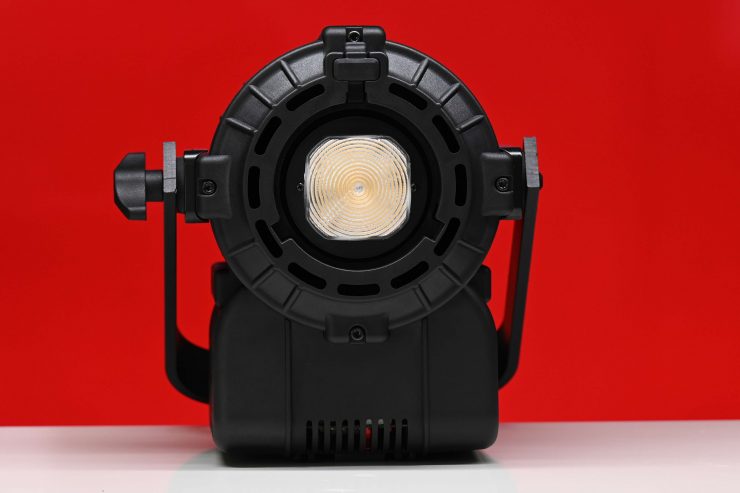
The Lupo Movielight 300 Dual Color PRO is a well-built, versatile, powerful spotlight that still manages to be reasonably compact and lightweight. It is nice that it can be run remotely off a single battery. It is nice that you can also use a single flight safe battery and still get around 60% of the total output from the fixture.
The light offers quite a lot of output considering its power draw and it has good color accuracy once you factor in all of the data from my testing.
If you are a solo operator, work in small crews, or travel a lot, the Lupo makes a lot of sense. Its versatility, power draw, and relatively compact size, and low weight make it worth looking at.
Like what we do and want to support Newsshooter? Consider becoming a Patreon supporter and help us to continue being the best source of news and reviews for professional tools for the independent filmmaker.

